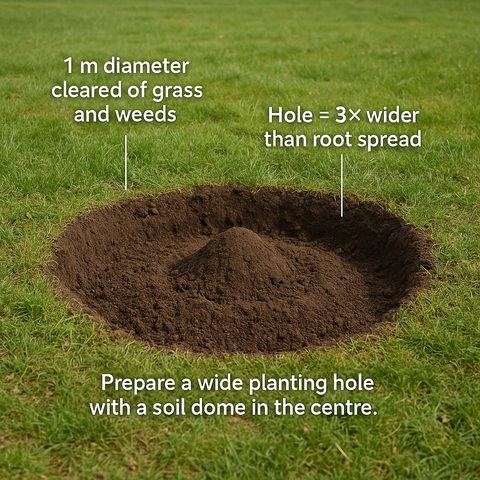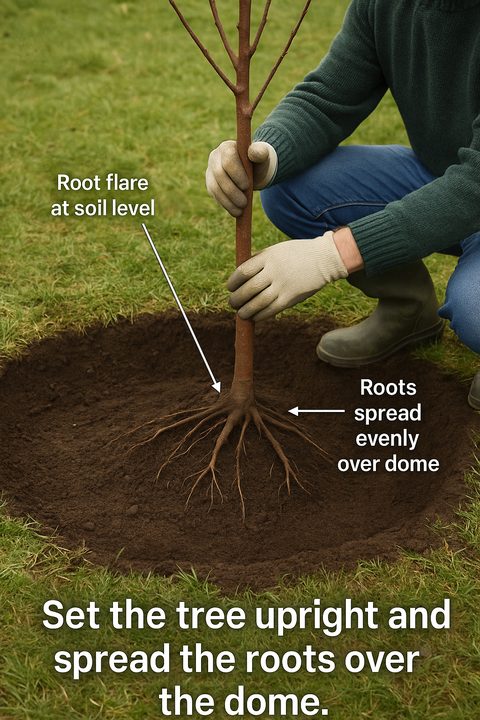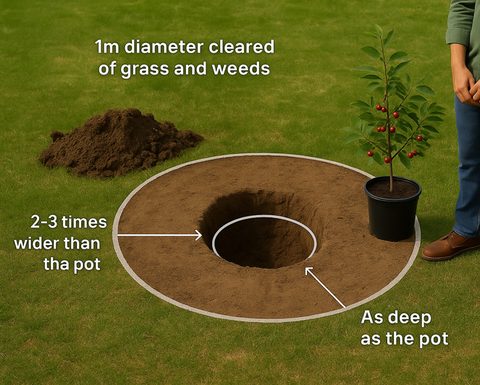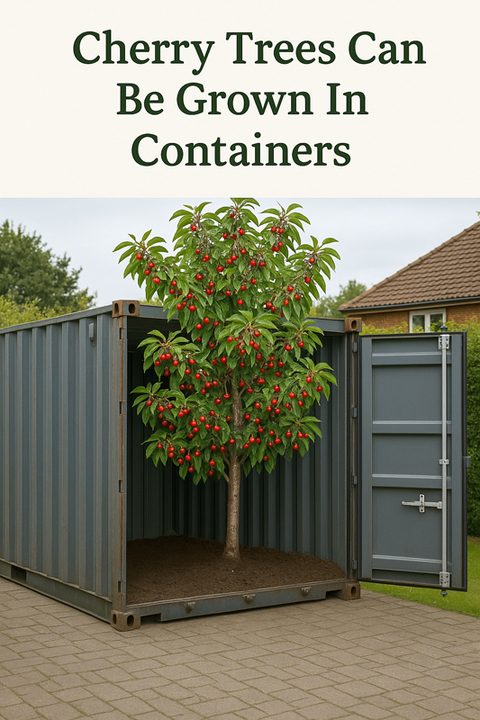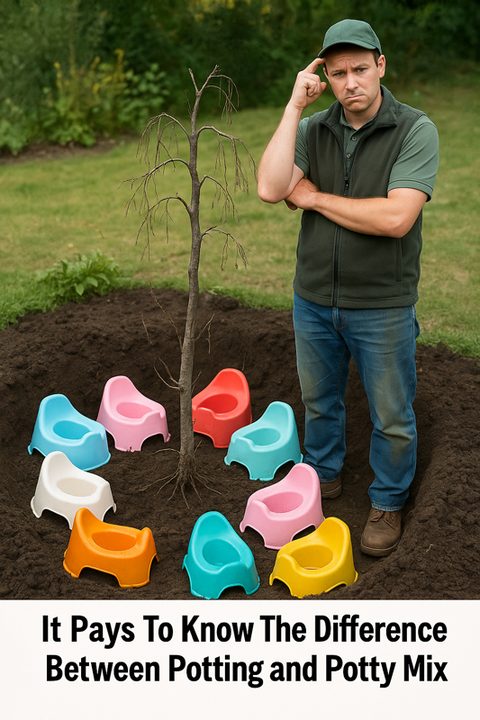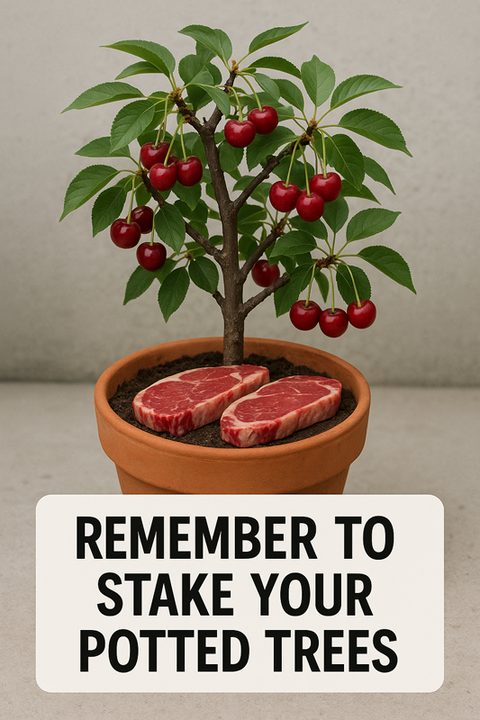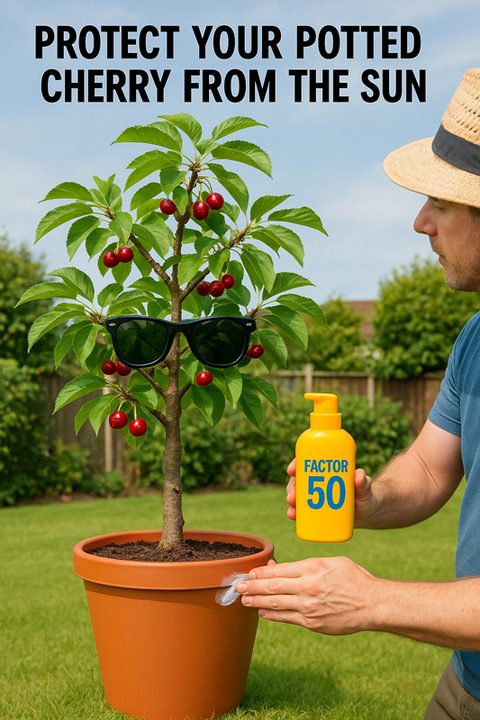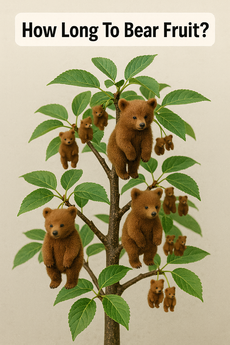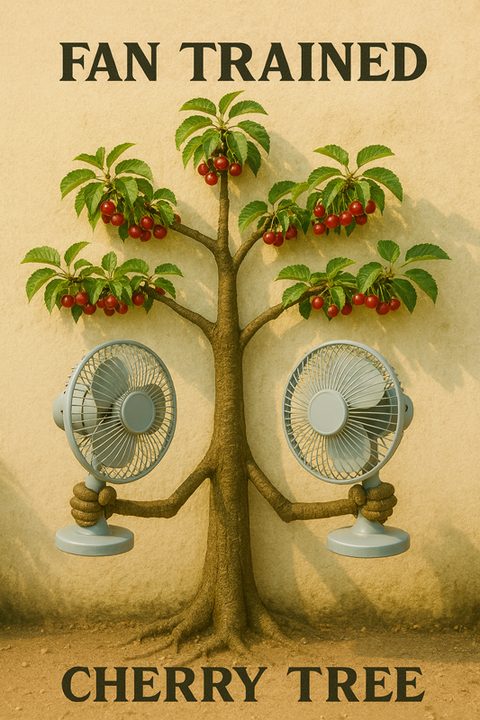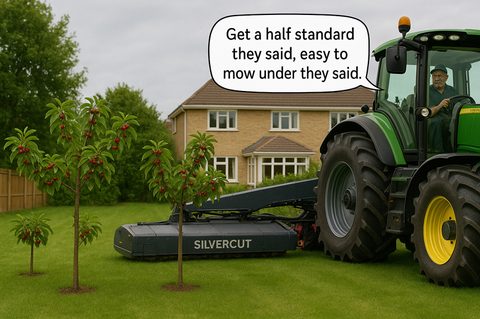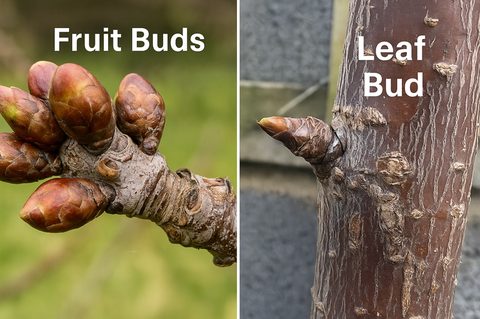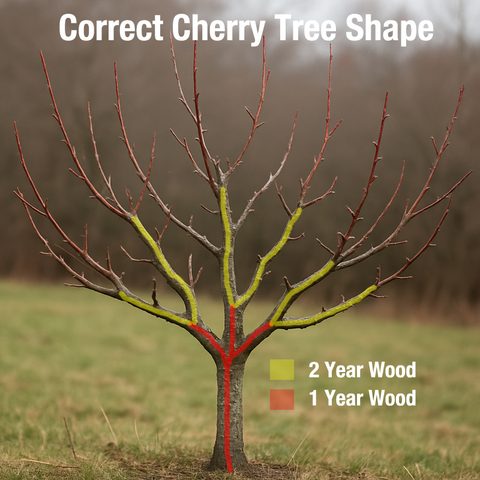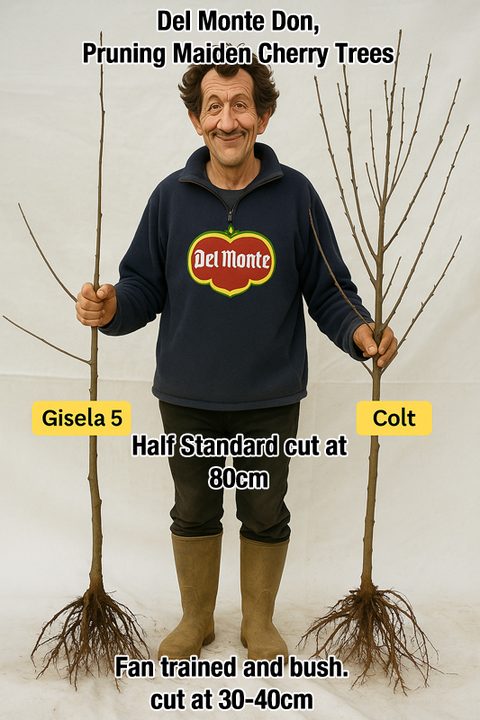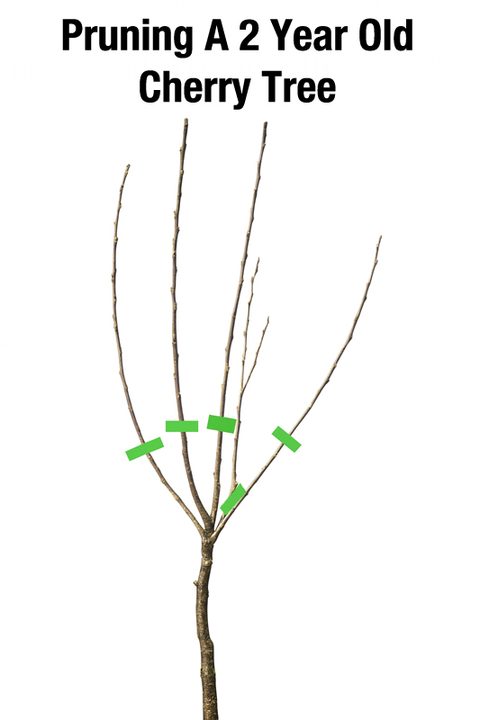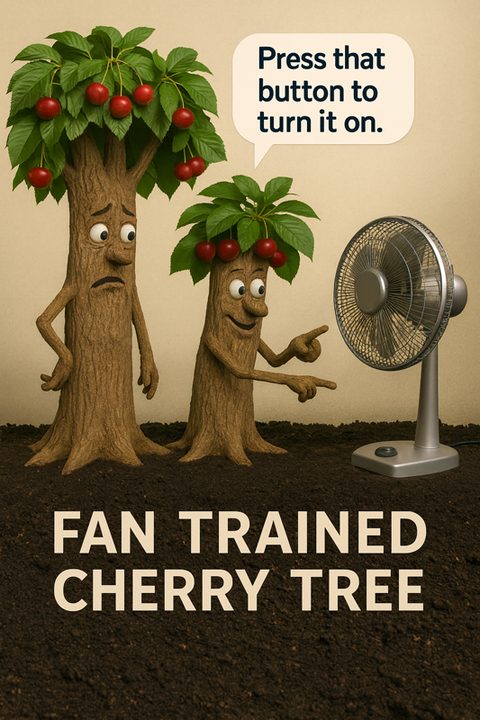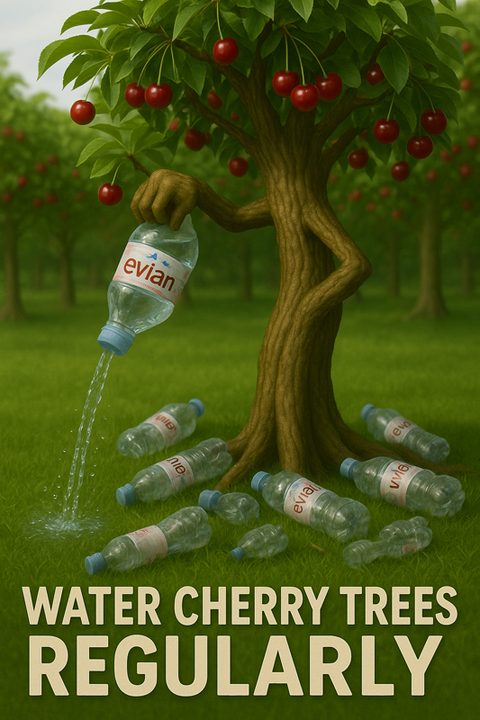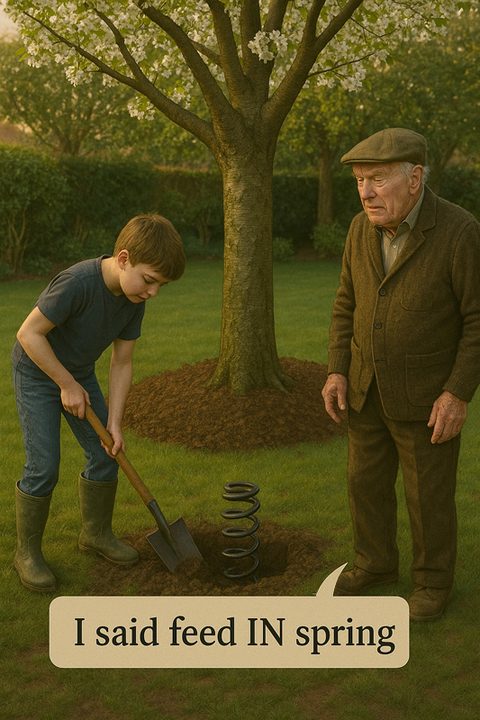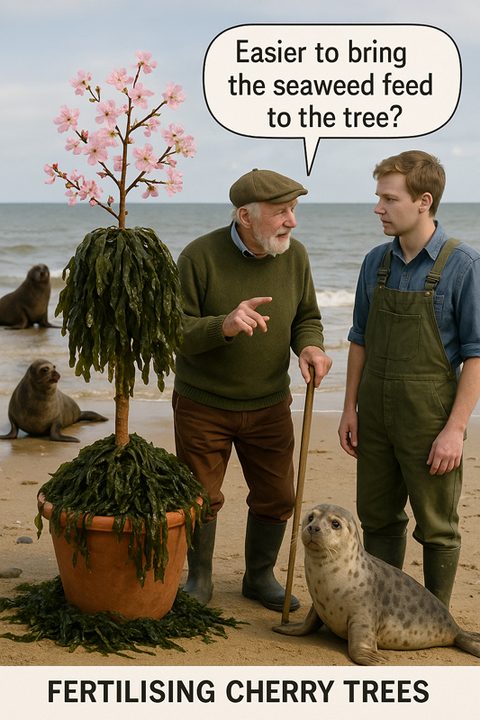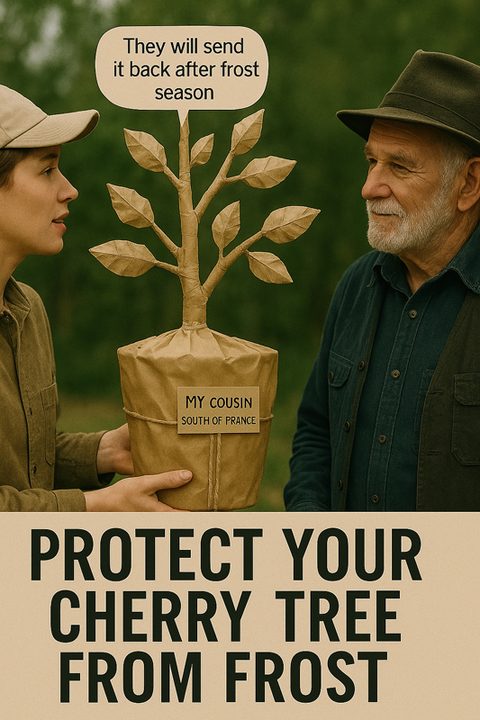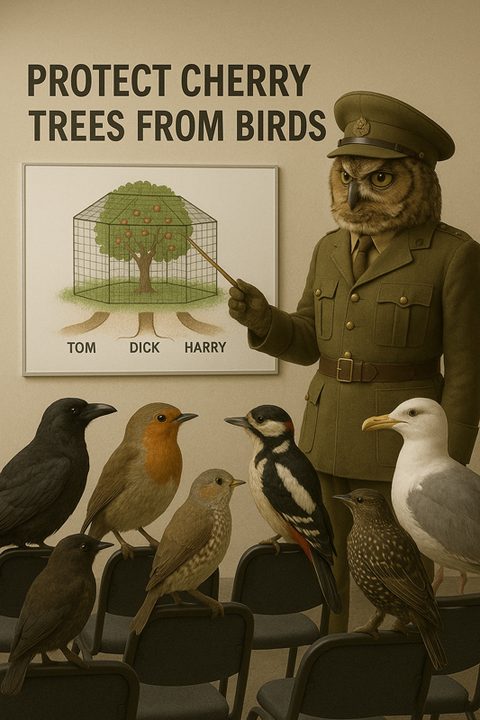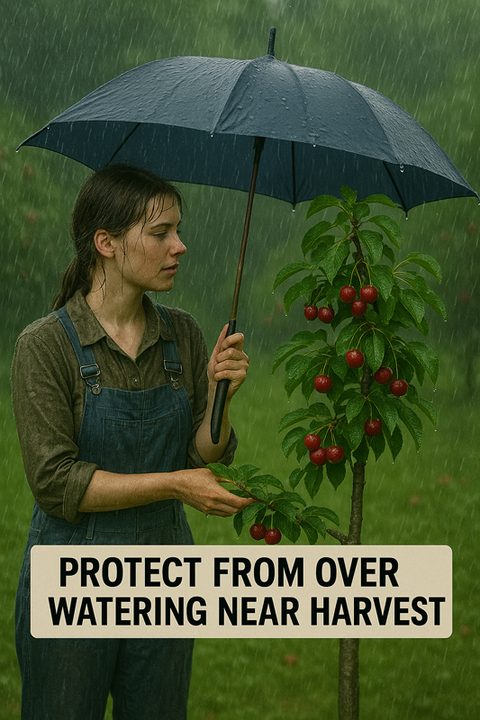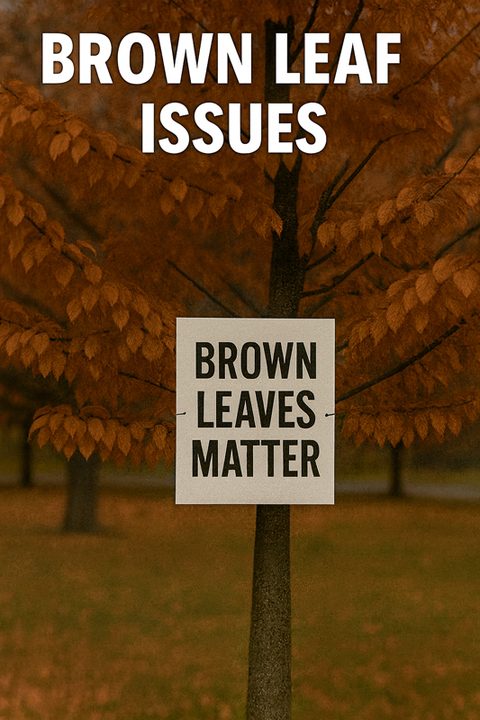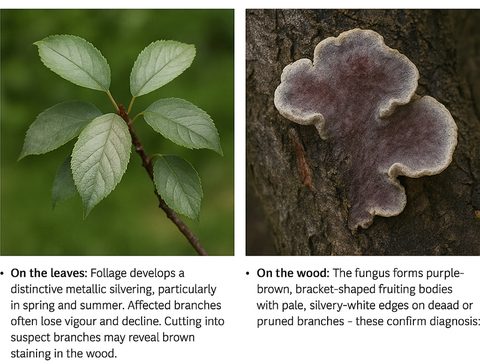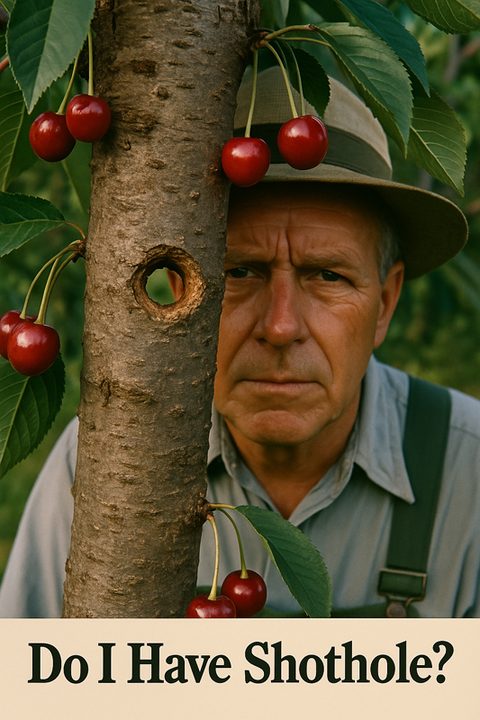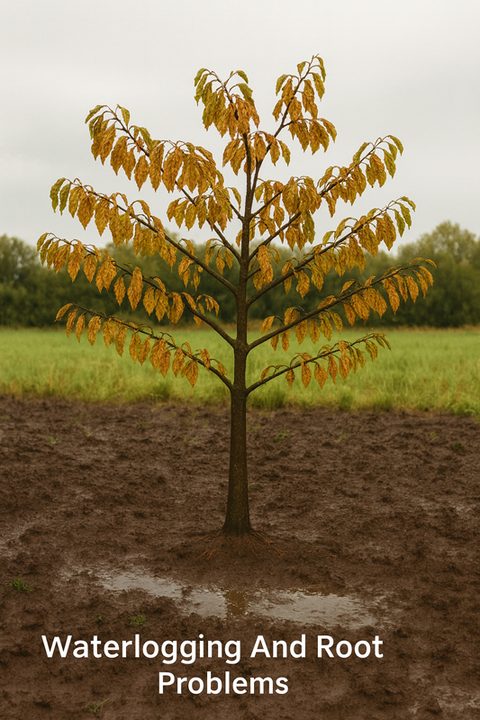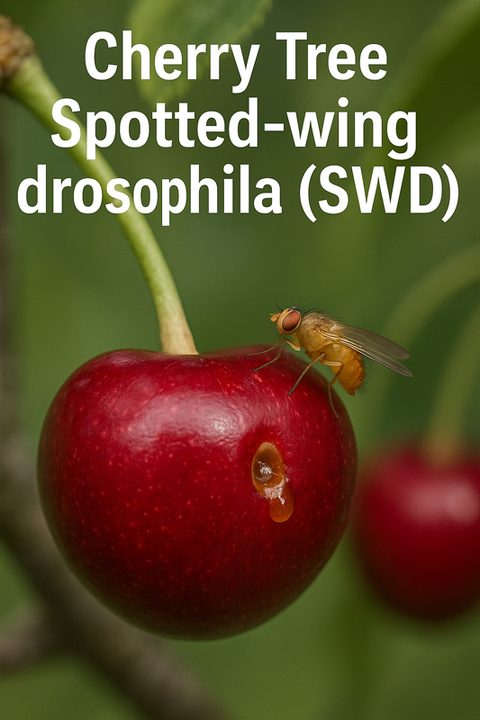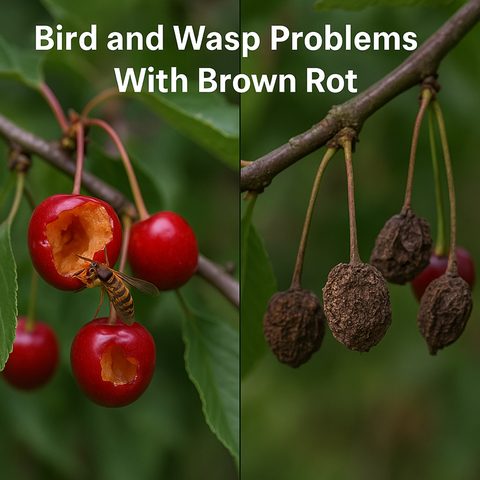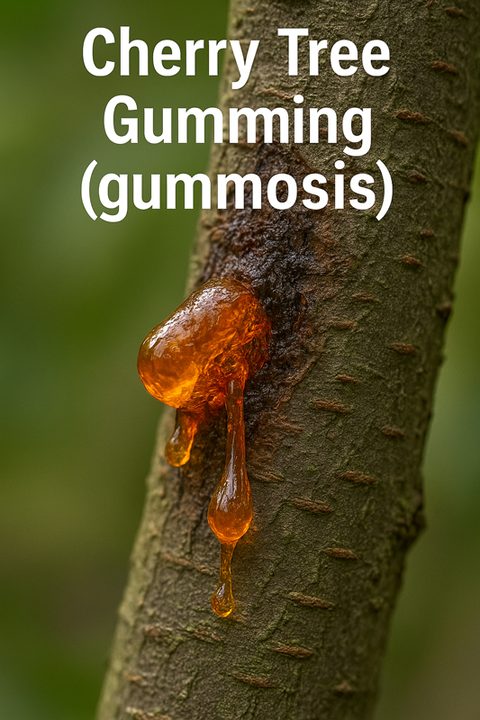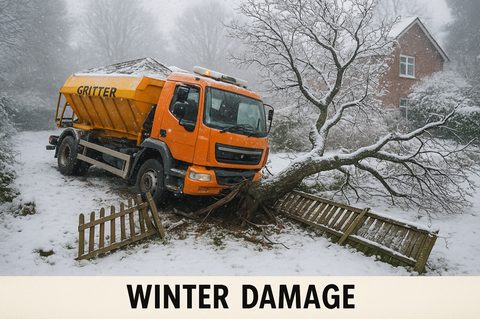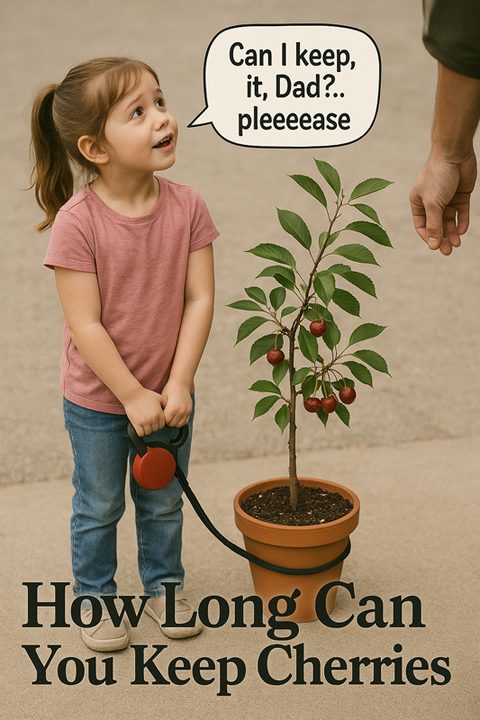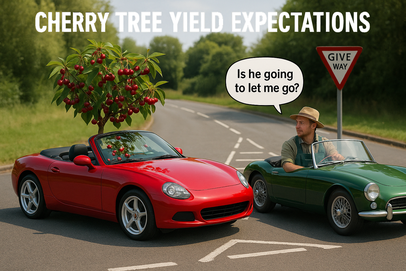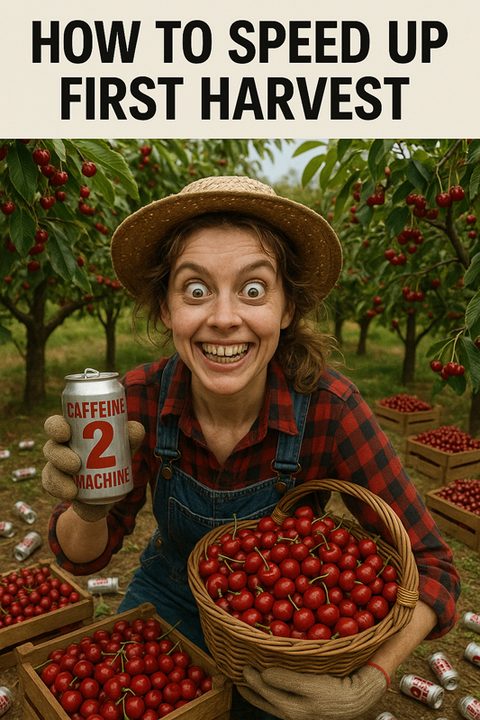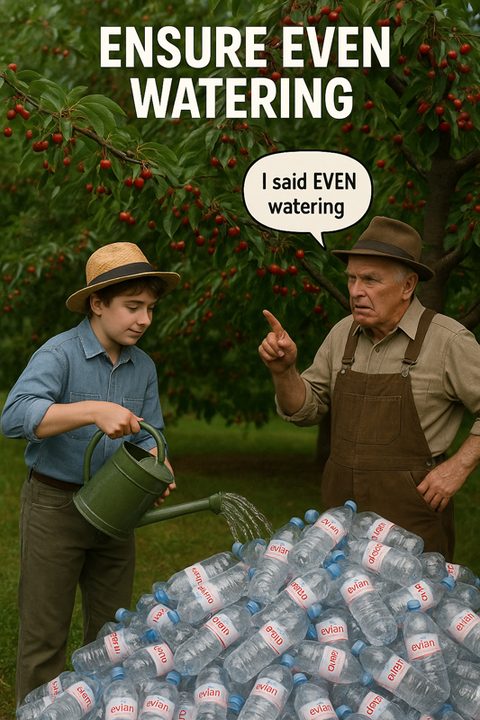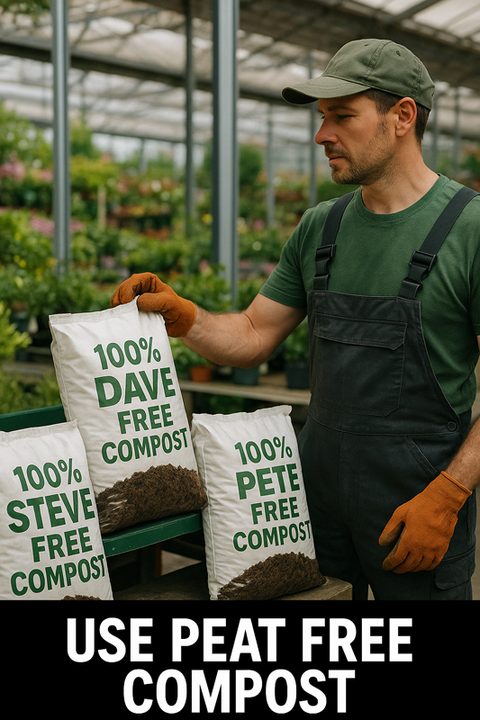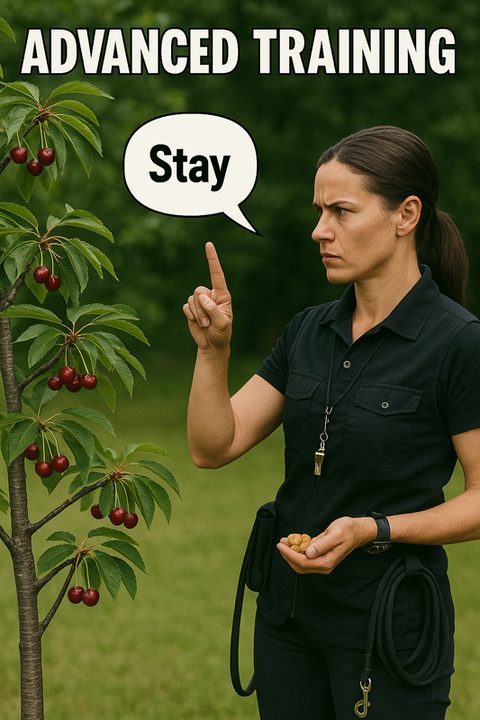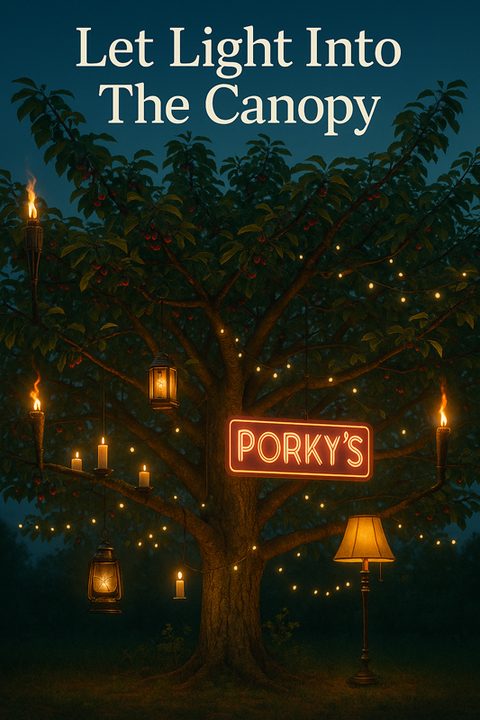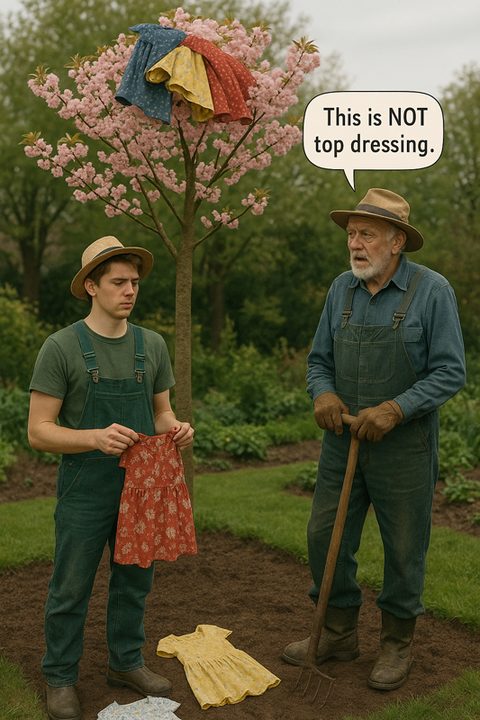Just Tell Me What Cherry Tree I Need
For a dessert cherry i.e. eating, get a Lapins Cherokee, Celeste, Sweetheart, Sunburst, Stella or Summer Sun.
For a sour cherry i.e. cooking cherry tree, get a Morello. These have all received awards from the RHS and will produce fruit with no other cherry trees near by and give good results across the whole UK. If those are unavailable, get any that are self fertile. There are plenty of great reasons to buy a different cherry tree to those listed. Some have a richer taste, are more disease resistant, split less or you may need a pollination partner to increase fruit yields. Now it is worth while reading further.
Introduction
Cherry trees can be a very rewarding fruit tree in the UK, possibly because nailing wanted posters and lost pet flyers to them can yield financial fruit that is available all year round. They also offer seasonal beauty and delicious summer harvests.
In early spring, they put on a spectacular display of white or pink blossoms[1], so if you purchased an unknown cherry tree, then you can realistically expect “whink” coloured blossoms (White or Pink). Good job the colours were not SHell and whITE).
Both shades are not only beautiful but also provide an important early nectar source for pollinators[2] to suck up— unlike a Nectar card, which provides nothing but a headache no matter how much you suck on it.
By mid-to-late summer, these blooms turn into rich, glossy fruits ranging from succulent, sweet cherries for eating fresh, to sharp, flavourful sour types ideal for cooking, jams or preserves[3]. Unlike many other fruits, cherries ripen earlier, often by late June[4], meaning you’ll be snacking while the apples and pears are still growing.
Many modern cultivars are self-fertile[5], meaning they will produce fruit if planted on their own and have rootstock options to provide larger cherry trees to smaller pot-grown patio trees. Available in different shapes or forms to give different benefits, covered later in this article.
Considered to be low maintenance and suitable for most environments[6]. Cherry trees crop earlier than apples and pears, avoid the large crop/sucky crop cycle of plums[7], and provide a very generous and thoughtful food source for the birds[8] (a perspective most commonly found with gardeners who forgot or couldn’t be bothered to net their trees).
Growing Cherry Trees In The UK
Cherry trees can be grown successfully across the UK, but the choice of variety and growing method makes a big difference. Dessert sweet cherries (Prunus avium) love warmth and shelter, so they perform best in southern and central England[3]. Gardeners further north — in Yorkshire, the North East, or into Scotland — can still grow sweet cherries, but the climate makes them more unpredictable. Shorter, cooler summers often mean smaller crops, and wet weather close to ripening increases the risk of fruit splitting[9]. Microclimates like sheltered courtyards and walled gardens can improve crop yields[10].
That doesn’t mean northern growers should give up on sweet cherries altogether. There are practical ways to tilt the odds in your favour. Training a tree as a fan against a sunny, south-facing wall captures extra heat and protects blossom from wind[10]. We mean fan shaped not teaching your tree to move air around.
Growing under a polytunnel, greenhouse, or rain shelter prevents excess moisture that leads to splitting and also warms the microclimate[11]. Choosing later-flowering, self-fertile cultivars such as ‘Stella’ or ‘Lapins’ helps avoid frost damage to blossom in cooler springs[12]. Consistent watering during dry spells, combined with good mulching, reduces stress and helps fruit ripen more evenly[3].
By contrast, sour cherries like the tough ‘Morello’ (Prunus cerasus) are reliable croppers almost anywhere in Britain[13]. They’ll tolerate partial shade and even thrive on a north-facing wall[10], making them one of the few fruit trees that actively suit tricky northern plots. With fertile, well-drained soil and some attention to site selection, gardeners right across the UK can grow cherries — but above the Midlands, a little protection and later flowering cherry trees make the difference between cherry-pick the best ones and cherry-pick the stressed ones.
Cherries do best in fertile, well-drained soils with a neutral to slightly acidic pH of around 6.5–6.7[14]. They dislike heavy clay or waterlogged ground, which can encourage bacterial canker and poor root growth[15], so improving drainage with organic matter or planting on a slight mound can make a big difference. While they’ll tolerate lighter sandy soils, these dry out quickly, so regular mulching is essential to conserve moisture[16]. In short, cherries are happiest in moisture-retentive but free-draining ground — the same balance most fruit trees prefer.
Choosing The Right Cherry Tree
Sweet vs Sour: Dessert Vs Cooking
Cherries fall into two main groups.
When ripe and about to fall, those facing the sun have a fatter and juicier side that makes them roll south after they hit the floor, while the others roll north i.e. creating two distinctive main groups after they have fallen. If you believe that, we have some magic beans for sale.
Sweet cherries are grown mainly for fresh eating, prized for their sugar content, juicy texture and larger fruit size, often in the 19–28 mm range[17]. Their glossy, firm flesh makes them ideal straight from the tree or in desserts with little added sugar.
Sour cherries, by contrast, average 15–20 mm[18]. Usually too tart to eat raw, they excel in bakes, preserves and drinks where their sharpness gives depth of flavour.
In the UK, sweet cherries crop from late June to July, with cultivars like ‘Celeste’ early and ‘Sweetheart’ extending into August[3]. Sour cherries ripen slightly later, July into early August, and because they flower later, they are more reliable in cooler or wetter regions[13].
Weather is critical. Sweet cherries often split after heavy rain near harvest[9]. Sour cherries resist cracking better and crop more consistently. Storage also differs: sweet cherries last only about seven days refrigerated[19], while sour cherries are usually processed immediately for freezing, canning or drying where they hold flavour well[20].
In the kitchen, sweet cherries need little sugar but can taste bland once baked, while sour cherries almost always require sweetening yet give a sharper, more intense flavour in pies and preserves[18]. Both provide vitamin C, potassium and fibre, but sour cherries have higher anthocyanins and melatonin, linked to reduced inflammation, faster recovery and better sleep[21].
In short, if you’re going to cherry-pick: sweet cherries win for fresh eating and looks, while sour cherries win for hardiness, reliability and culinary punch.
Pollination & Self-Fertile Cultivars
This is how a cherry tree “loses it’s cherry”.
There are three components required, an anther, stigma and pollen and a cherry tree flower has all three of these inside each flower. Pollen grown on the anther will fertilise the stigma and a fruit will grown. Cherry trees that can do this are called self-fertile. If the pollen does not fertilise the stigma then these are not self-fertile. These will require the pollen from a different species of cherry tree.
In cherries, as in many fruit trees, pollination is carried out mainly by insects such as bees, which move pollen between blossoms as they forage[22]. They work a bit like a fertility clinic in that they are busy bees working amongst the stigma.
Nurseries label trees with a pollination group (usually a number or letter) that marks a two-week flowering window. For best results, choose another tree from the same group, or one above or below, to guarantee flower opening overlap and successful pollination. Modern cultivars such as Stella, Lapins, and Sunburst are self-fertile, while older types like Van or Bing require pollination partners[5][23]. Most good tree retailers will list a cherry tree's fertility status.
Even self-fertile cherries, however, often crop more heavily when a second compatible tree is nearby. Cross-pollination by bees can increase crop size, so expert gardeners often plant more than one type of cherry tree if space allows[24]. For sour cherries like Morello, which are naturally self-fertile, yields are reliable even in isolation, but cross-pollination may still improve consistency[13].
For maximum effect, cherries should be planted within about 25 m of each other so that bees can move easily between them[25]. As with most prime real estate, positioning them in sunny, sheltered sites with good airflow encourages Air Bee and Bee stays along with other insect activity. Avoid spraying insecticides during blossoming to protect visiting bees. Where only one tree can be grown, choosing a self-fertile variety is best. In summary, a self-fertile cherry tree can “GO FERTILISE ITSELF!” whereas a non-self-fertile tree cannot; it needs a hand.
Rootstocks & Sizes
Cherry trees are like people, not in the way we can get fruity, throw shade, and creak when old but a mixture of two things coming together. Some people might call them “Frankenstrees,” but the industry calls them grafted. This is where you join or graft the roots of one tree onto a piece of another. The idea is to merge the benefits the roots offer with the benefits the fruiting part has to offer. A bit like merging capitalism with socialism — more benefits all round. The rootstock is the root system plus a small section of stem taken from another tree. It provides qualities such as strength, size control, soil adaptability, and disease resistance. Onto this, the scion is grafted — not Cylon, because we want cherries, not human-killing robots. The scion is the part that grows into the fruit-bearing section. You can usually spot the graft union as a slight bulge about 30 cm above ground. Everything above it is the scion, responsible for flavour, sweetness, and yield[26][27].
Rootstocks strongly influence tree vigour. A vigorous rootstock can produce a tree up to 10 m tall, while dwarfing and ultra-dwarfing rootstocks restrict growth to a much smaller size, between 2–4 m, perfect for small gardens or containers. Dwarfing also encourages earlier fruiting, meaning you’ll enjoy cherries much sooner than on a traditional orchard-sized tree[28][29].
Common cherry rootstocks in the UK include:
VVA-1 (Krymsk® 5): Ultra-compact, typically 2–2.5 m tall. Perfect for patios, containers, and fans, with very early cropping. Needs fertile soil, regular watering, and staking for support[30].
Gisela 5: A popular dwarfing rootstock, producing trees around 3–4 m. Excellent for small gardens and trained forms, though it benefits from staking and good feeding[31][31].
Colt: A semi-vigorous rootstock, giving mid-sized trees about 3.5–6 m. Tolerant of heavier soils and less demanding, making it popular for average UK gardens[31][32].
Mazzard / F12/1: A traditional vigorous rootstock, producing large trees of 6–10 m. Suited to orchards and parkland, but impractical for smaller plots[31][28]. Opting for vigorous rootstocks such as Mazzard or F12/1 may sound like a bold move, but it brings a whole new set of challenges. These trees can reach 6–10 m tall, which means pruning isn’t a quick job with a pair of secateurs — it’s a full-on operation. You’ll need tall ladders, long-reach saws or pruners, and ideally safety gear such as harnesses or scaffolding. Cuts on such large trees are thicker, slower to heal, and more prone to fungal infections, so every pruning decision carries extra risk. What’s manageable on Colt or Gisela 5 becomes an exercise in logistics on Mazzard or F12/1. For most gardeners, this scale of tree care is better left to professionals, unless you fancy turning cherry pruning into a high-altitude extreme sport.
Growing Cherry Trees From Seed
While most edible cherry trees in UK gardens are grafted onto rootstocks to achieve optimal results, it is possible to grow cherries from seed. Wild cherry (Prunus avium), often called “Gean”, naturally reproduces this way and has been raised from seed for centuries for timber, hedgerows, and ornamental planting[32]. If you ever wanted to sow the seed of doubt about cherry taste, try a Prunus avium cherry, you might think the bark tasted better.
Seed-grown cherries are genetically variable. A tree raised from a cherry stone may not resemble its parent in fruit quality or size — and in many cases the fruit is smaller, less sweet, or even poor for eating. This is because cherries are cross-pollinated, so the seed carries mixed genetics[18]. For this reason, commercial and garden fruiting cherries are almost always grafted rather than seed-grown so you can literally benefit from someone else’s hard graft.
For example, if you plant a stone from a Stella cherry, the seedling will not grow into another Stella. You likely will not get stellar results and won’t be raising a pint of Stella to celebrate. Instead, it will be a new, genetically unique cherry tree. Because Stella is self-fertile, the pollen parent might also be Stella, but the result is still a genetic reshuffle. The seedling could produce good fruit, but more often it’s unpredictable — sometimes smaller, more sour, or later to ripen. That’s why nurseries propagate Stella by grafting, not by seed.
That said, cherries grown from seed can still be valuable. They make attractive trees for wildlife and pollinators, provide excellent timber (cherry wood is prized in furniture so ideal for beginners looking to get wood and lose their furniture-making cherry in the workshop), and can even be used as rootstocks themselves once established[26]. Some gardeners enjoy raising cherry seedlings simply for the challenge or for the surprise of what fruit might appear. These gardeners have a lot of thyme on their hands.
If you want to try, cherry seeds need a cold stratification period — usually around 8–12 weeks in moist compost kept at fridge temperatures — to break dormancy before they will germinate[33]. Even then, patience is required: seedlings may take 7–10 years to produce fruit, and the results will be unpredictable. Best Eating Cherries for UK Gardens
Cherry picking the best is subjective because it may well be the rock star of fruit, but if it needs so much nurturing you have to read it a bedtime story, you won’t want it. Popular cherry trees have qualities such as flavour, reliability, self-fertility, resistance to splitting, and how well the tree copes with our climate.
Often Suggested “Best” Dessert Cherries
Lapins (‘Cherokee’) — Self-fertile, heavy crops of large, well-flavoured dark red fruit; reliable in UK gardens. RHS AGM: Yes [34][3][35].
Stella — The classic self-fertile garden cherry; large, rich fruit, regular heavy crops (can split in very wet spells). RHS AGM: Yes [50].
Sunburst — Self-fertile, large very dark red cherries with good flavour in mid-season. RHS AGM: No [36].
Sweetheart — Self-fertile, very late cropper with a long picking window of sweet dark-red fruit; precocious. RHS AGM: Yes [37].
Summer Sun — Productive mid/late-July cherry noted by UK sources for coping with cooler, dull summers; not self-fertile. RHS AGM: Yes [38].
Kordia — Large, firm “black” cherries, good flavour; some crack resistance; not self-fertile. RHS AGM: Yes [156].
Sylvia — Naturally compact/columnar habit (good for pots), large firm dark cherries; partially self-fertile (better with a partner). RHS AGM: No [157].
Regina — Late, firm dark cherries with good crack resistance; needs a pollinator. RHS AGM: No [158].
Penny — British-bred, very late season, large firm dark fruit; compact tree; not self-fertile. RHS AGM: Yes [159].
Merchant — Early, reliable heavy crops of well-flavoured dark fruit; not self-fertile. RHS AGM: Yes [160].
Celeste (‘Sumpaca’ PBR) — Early, self-fertile, naturally less vigorous (2–3 m), sweet dark-red fruit; ideal for small gardens/containers. RHS AGM: No [161].
Skeena — Modern self-fertile dark cherry producing very large, firm fruit; widely praised in comparisons. RHS AGM: No [162].
These varieties consistently feature in RHS lists, UK nursery catalogues, and expert recommendations.
How “Best” Is Decided
Expert reviews & awards – RHS Awards of Garden Merit, nursery trials, and decades of gardener feedback carry weight.
Sales & consumer demand – UK shoppers overwhelmingly prefer British-grown cherries; seven of the top 10 selling varieties are home-produced[39].
Flavour & storage – Some cherries taste phenomenal but bruise quickly; others like Lapins combine flavour with firmness, making them favourites for both gardens and supermarkets.
Ease of growing – For many gardeners, self-fertility is the clincher (for the cherry, not themselves)
Location and Climate Factors
Northern or cooler sites – Varieties like Summer Sun (bred in the UK) and sour Morello cope better with chillier weather[40].
Frost pockets or semi-shade – Morello cherries tolerate colder, less sunny sites than sweet cherries.
Wet summers – Splitting becomes a risk; Lapins and Sylvia cope better by either resisting cracks or hiding fruit beneath leaves[41].
Small gardens – Compact, self-fertile types (Stella, Lapins, Sylvia) on dwarfing rootstocks like Gisela 5 are best choices.
Weather Makes the Difference
Cherries are dramatically influenced by seasonal weather.
Warm, dry summers = plumper, sweeter, firmer cherries (2025 produced the UK’s largest cherry crop in years)[42].
Wet spells at ripening = higher risk of fruit splitting and softer cherries.
Milder springs = longer UK cherry season, sometimes nearly doubled compared with a decade ago[43].
Takeaway, by that we mean opinion and not Chinese.
The best UK eating cherries are not chosen on taste alone. They’re backed by RHS awards, expert reviews, consumer preference, and resilience to the UK’s unpredictable weather. Your own “best” will depend on garden size, location, and whether you want early or late fruit.
Dwarf / Small-Garden Options
Not everyone has the space for a cherry tree that can grow to 6 m high. Luckily, dwarfing rootstocks mean you can enjoy cherries even in a modest back garden or on a patio.
What Is a Dwarfing Rootstock?
In short, the roots of another tree. Usually from a Prunus avium, hybrids of Prunus avium, hybrids of Prunus cerasus + Prunus canescens and Prunus fruticosa (dwarf cherry) and Prunus cerasus. These give you rootstocks such as Mazzard, Colt, Gisela 5, Gisela 6, F12/1 and Krymsk.
By carefully selecting the rootstock, breeders can control the eventual size, vigour, and productivity of the tree[44].
This is how you can get one Stella tree to grow to 3m while another grows to 6m. Still the same tree, just grafted onto different rootstock.
How Is Dwarfing Achieved?
Dwarfing is the result of natural genetic traits in the rootstock. Some cherry rootstocks naturally produce smaller, less vigorous growth.
Grafting a piece of another tree (scion) onto these rootstocks restricts sap flow and growth hormones, which keeps the canopy compact without affecting fruit quality.
This allows nurseries to tailor cherries for orchards, gardens, or patios simply by changing the rootstock—not the fruiting variety itself[44][45].
Pros of Dwarfing Rootstocks
Manageable size – easier pruning, netting, and harvesting without ladders[46].
Earlier cropping – dwarf trees often fruit 1–2 years earlier than vigorous ones[44].
High yields per square metre – compact trees channel energy into fruit rather than endless wood growth.
Better suited to containers or small gardens.
Cons of Dwarfing Rootstocks
Shallower roots – less drought-resistant; need regular watering and mulching[45].
Shorter lifespan – may live 15–20 years, versus 30+ years for vigorous trees.
More prone to leaning – sometimes require staking for life.
Lower ultimate yield – while yields per area are high, one tree will give less overall than a large vigorous tree.
Common Cherry Rootstocks And Their Benefits
Gisela 5 – Semi-dwarf. Final height ~3 m. Precocious (fruits early), high-yielding, but needs good soil and support. Excellent for small gardens and containers[44].
Colt – Semi-vigorous. Final height ~4–5 m. Hardy, adaptable, tolerates poorer soils. A good all-rounder for UK gardens that still want “big tree presence” but not unmanageable growth[46].
Mazzard (Prunus avium seedling) – Vigorous. Final height ~6 m. Traditional orchard rootstock, long-lived, but far too big for small gardens[45].
Gisela 3 / Gisela 6 – Less common but offer variations in dwarfing strength; Gisela 3 very dwarfing (rare in the UK), Gisela 6 is slightly larger and more tolerant of stress[44].
Which Rootstock Should You Choose?
Tiny gardens / containers – Gisela 5 (precocious, compact, heavy cropping).
Medium suburban gardens – Colt (manageable with pruning, reliable, hardy).
Large plots or traditional orchards – Mazzard (long-lived, big, and impressive).
Takeaway
If you’re short on space, the rootstock is as important as the variety. A Lapins on Mazzard might need a cherry-picker; a Lapins on Gisela 5 can live happily in a pot. Dwarfing rootstocks don’t change the fruit—just the size, manageability, and how quickly you’ll enjoy your first harvest. For most UK gardens, Gisela 5 or Colt will strike the best balance between flavour, yield, and practicality.
Where to Plant Cherry Trees in the UK
Easy! On land that you own because the council don’t like random orchards on their motorway roundabouts.
A well-placed cherry tree will flower well in spring and provide plenty of fruit in summer; a poorly placed one will sulk, split, or just refuse to perform. If you get lots of flowers unexpectedly, someone might think you’ve taken up baking.
Do Cherry Trees Need Full Sun?
The sweet dessert cherries do — they thrive in full sun. Sunshine not only boosts flowering and fruit ripening but also reduces disease risk by keeping leaves drier [3], making it harder for fungal diseases like canker and blossom wilt to take hold. Shade-grown dessert cherries tend to be leggy, with fewer flowers and lower-quality fruit.
Sour cherries (like Morello, Prunus cerasus) are more tolerant of partial shade, making them a good option for north-facing walls or shadier plots [47]. You can talk to it in shades of grey, show it shady behaviour, shout that it is a pale shade of a dessert cherry, and throw it some shade — and it will still perform — but you can’t keep it in the dark.
Soil & Drainage Requirements
Free-draining soil is crucial. Cherries hate “wet feet” and are prone to root and bacterial problems in waterlogged ground [48].
They prefer deep, fertile, moist-but-well-drained soil [3] with a pH of slightly acidic — around 6.5–6.7, according to RHS advice [3].
How Far from the House?
This depends on the rootstock used. Simplified, the taller the tree, the further the roots grow. The further the root from the tree, the smaller the roots will be and less of a problem. Cherry trees are shallow roots so old clay drains, paving slabs etc might be affected. It is worth while knowing how far the roots grow because they might grow into something like old builders rubble buried in the back garden and alkaline cement bags have caused problems historically.
How Far Apart to Plant?
Why is spacing important when planting cherry trees? [51]
Proper spacing improves airflow (reducing fungal problems), light exposure (better blossom and ripening), reduces root competition for water and nutrients, and leaves access for pruning, netting and harvesting.
Does spacing depend on the rootstock?
Yes. Rootstock dictates eventual size and spread (e.g. Gisela 5 is semi-dwarf; Colt is semi-vigorous), so spacing scales with vigour. [3]
How far apart should dwarf or semi-dwarf cherries be planted?
On Gisela 5, plant about 3.0–3.5 m apart (10–11.5 ft). This balances airflow and access while keeping trees compact for smaller gardens. [53]
How far apart should semi-vigorous cherries be planted?
On Colt, allow roughly 3.6–4.5 m (12–15 ft) between trees. Colt is common in UK gardens and produces medium-sized trees that still need space for pruning and netting. [49]
How far apart should vigorous cherries be planted?
Mazzard / F12/1: use 6–8 m (20–26 ft) for standard orchard-style spacing; 8–10 m if you want wide alleys and maximum airflow. [49]
Can I plant cherry trees closer if I prune them?
Yes, within reason. Training (e.g. fan-training) and consistent summer pruning let you keep trees narrower. As a rule of thumb, fans are often set around ~2.5 m apart; note that a mature fan on Gisela 5 can reach ~3.5 m wide if you let it. [54]
How close do cherry trees need to be for pollination?
For cross-pollination, a practical rule is to keep compatible trees within about 18 m (55 ft) so pollinators can move easily between them. (Self-fertile cultivars still benefit from a partner nearby.) [55]
Can I plant cherries in a row or hedge style?
Yes — if you train them (fans/espaliers). Typical advice is ~2.5 m between fan/espalier trees along a wall or fence, provided you maintain their width with pruning. [54]
What spacing is best against a wall or fence?
Plant 20–30 cm out from the base of the wall/fence to avoid the driest soil, then allow ~2–3.5 m width per trained tree (depending on rootstock and how strictly you prune). [57]
What happens if I plant cherry trees too close together?
You’ll get shading (poorer crops), reduced airflow (more disease), root competition (slower growth/less resilience), and poor access for pruning, netting and picking. [51]
When & How to Plant
Best Time of Year (Bare-Root vs Container)
Bare-root cherries should only be planted during dormancy, November–March in the UK, provided soil is not frozen or waterlogged.
What is dormancy? Dormancy is the tree’s “resting phase” — it has no leaves, no active growth, and very low metabolic activity. In this state, roots can be disturbed and replanted with minimal stress [58].
Why bare-root cannot be planted outside dormancy: Once buds swell or leaves emerge, sap is flowing and roots need a constant supply of water. A bare-root tree at this stage will dry out rapidly and often die if not planted.
How to recognise dormancy ending: Signs include swelling buds, visible green tips, or new leaf growth. A quick check is the “scratch test”: gently scratch a bud — if green tissue is showing, the tree is waking up and should be planted immediately.
If you cannot plant right away: Preserve dormancy by “heeling in” (temporarily covering roots with moist soil or compost outdoors) or keeping roots wrapped in damp sacking/coir in a cool, shaded, frost-free place. The aim is to keep roots moist, cool, and dark until planting [59].
Container-grown cherries can technically be planted year-round, because roots stay in their soil/rootball. However, the best establishment occurs in autumn (Sep–Nov), when soil is still warm and moisture is rising, and spring (Mar–Apr), when roots naturally resume growth. Winter planting is possible, but root growth is minimal until soils warm; summer planting works but requires vigilant watering and mulching to avoid stress [58][60].
Planting Bare-Root Cherry Trees In The UK
When to buy & plant
Buy dormant trees only. Purchase and plant November to March while fully dormant (no leaves). If bare root plants are available in April, we either had a cold spell, the nursery uses cold storage or you are taking a risk buying them. If there are leaves or buds starting to burst, don’t buy. You can plant immediately but it is a risk.If you can’t plant straight away in the dormant season.
If not planting straight away then you canh eel-in (best for weeks): In a sheltered, well-drained spot, dig a trench; splay roots and cover with moist soil/compost; firm lightly. Good for 2–6 weeks (weather-dependent).
Short hold (days): Keep roots wrapped in damp (not wet) material (coir/compost/sphagnum), bagged; store cool, dark, frost-free.
If buds begin breaking in storage, plant at once (or pot up) and keep cool and evenly moist.
Site check & drainage (do this first)
Percolation test
Dig a hole 30–40 cm deep, fill with water and let it drain. Refill once more.
If the water is still sitting after 12 hours then drainage is poor so plant on a raised mound or improve drainage before doing anything else.
If you have a clay layer, sometimes you can dig through it to get better draining soils. Soil pH
Cherries prefer pH 6.5–7.5.
If too acidic: add lime.
If strongly alkaline: incorporate organic matter to improve nutrient uptake.
Weed-free circle
Once drainage and soil are confirmed suitable, mark and clear a 1 m diameter circle of grass and weeds to reduce root competition.
Dig the hole & set the height
Size
Dig the hole about three times wider than the root spread, and only as deep as needed so the base of the trunk (where it flares into the top roots) will sit at soil level. If in doubt, dig a touch deeper — you can adjust the final height with the soil dome. If you put any soil back in to raise the height, be sure to firm it down to prevent the tree from sinking.
Soil dome
Build a firm mound of soil in the middle of the hole. It needs to be firm to stop the tree sinking and lets the roots slope gently outwards and downwards. Build the dome so that the roots will be around 45 degrees to the horizon i.e. pointing them towards the bottom of the hole.
Spread roots
Lay the roots evenly over the dome, spreading them out like spokes on a wheel. Make sure the finished soil line will match the original mark on the trunk created by the previous soil level.
Why it matters
Spreading the roots out stops them curling round on themselves, gives the tree a firm hold against wind from all sides, and helps it grow into the soil evenly all around.
Roughing the sides
If the sides are smooth and shiny from digging, roughen them so roots can grow through. This is common with clay soils.
Backfill (what to use—and avoid)
Use native topsoil, crumbled fine; backfill and firm gently in stages to remove air gaps—don’t stamp.
Do not add fertiliser or manure in the hole (risk of root burn, later sinkage burying the flare/graft, and “flowerpot effect” trapping roots in the pit).
Put organics on top as mulch, not in the backfill.
Why friable (crumbly) backfill matters
Most uptake happens via microscopic feeding root hairs. Friable, crumbly soil makes intimate contact with those hairs. Great lumps of clay need to be broken up.
Water, stake, mulch
Water in thoroughly to settle soil and eliminate voids.
Stake (only if needed see our article ). In short, if you are in a walled, fenced or surrounded garden, you likely won’t need to stake. If in doubt, use a short, single stake on the upwind side; one flexible tie 30–45 cm above soil so the trunk can flex slightly. Remove after 2-3 seasons.
Mulch: 5–8 cm organic mulch across the 1 m circle, leaving a 5–8 cm mulch-free collar around the stem.
Wet or heavy soils (workaround)
See Planting On A Raised Mound.
Optional: Mycorrhizae
Mycorrhizal inoculants (e.g., Rootgrow®) can aid early establishment on poor, sandy or disturbed soils. Benefits are site-dependent and often modest on good loams with proper mulching and watering. They don’t replace correct depth, drainage, and aftercare.
Protection (as needed)
Guards/fencing where rabbits/deer are present.
Keep the mulch-free collar visible to avoid strimmer damage; consider a rigid spiral or mesh guard in high-risk areas.
Remove/tweak labels/ties that could girdle the stem as it thickens.
Aftercare (first 1–2 seasons)
Watering: Check soil moisture before watering. Push a finger or trowel 10–15 cm into the soil near the root zone — if it feels dry and crumbly, water; if still moist, wait. A simple moisture meter can help, aiming for “moist” rather than “wet.” Watch the tree too: wilting, dull leaf colour, or early yellowing leaves are signs of drought stress. In dry spells, give a deep soak so water penetrates to spade depth, usually every 7–10 days (more often on sandy soils).
Weed & mulch: Keep a 1 m circle around the trunk weed-free. Top up mulch each year, but keep it clear of the stem to prevent rot and pests.
Staking: Inspect ties monthly and loosen as the trunk thickens. Remove the stake once the tree passes the “wiggle test” (the trunk flexes but the rootplate stays firm), usually after 18–24 months.
Feeding: Monitor growth in spring. If shoots are weak or leaves pale, apply a light, balanced surface feed or mulch with compost. Avoid heavy nitrogen fertilisers, which produce soft growth prone to disease.
Pruning cherries: Prune only in late spring or summer (unless pruning out damage), and choose a dry spell to lower canker risk. Focus on formative pruning — shaping the young tree into an open, balanced framework.
Quick pitfalls checklist
Flare/graft buried will lead to rot, poor vigour
The root flare (where the trunk widens into roots) must sit at or just above soil level. If it’s buried, bark tissues stay damp and rot, and gas exchange is restricted. If the graft union is buried, the scion may root from above it, defeating the purpose of the rootstock.
Glazed pit sides will lead to roots stall
On clay soils, digging can smear the sides of the planting hole into a smooth “glazed” surface. Roots hit this barrier and spiral rather than penetrating, leaving a tree that is slow to establish or unstable. Roughening the sides with a fork breaks this up.
Fertiliser/manure in the hole will lead to burn / sinkage / “flowerpot effect”
Fresh manure or concentrated fertiliser can scorch fine root hairs. Organic matter decomposes and shrinks, causing the tree to sink and bury the flare/graft. A rich pocket in the pit also creates a “flowerpot effect,” where roots circle inside instead of spreading into the surrounding soil.
Roots bunched to one side will lead to poor anchorage / lean
If roots are clumped together or not spread radially, the tree anchors unevenly. Wind pressure then pulls harder on one side, risking lean or windthrow. Even spreading gives balanced support and better access to soil resources.
Mulch on trunk will lead to rot / rodents
Mulch piled against bark traps moisture against the stem, softening tissues and inviting fungal decay. It also creates cover for voles or mice, which may gnaw the bark at ground level. Always leave a mulch-free collar (? 5–8 cm).
Roots ever allowed to dry ? high failure risk
Fine root hairs die quickly if exposed to air or sun. Even a few minutes of drying can cause permanent loss of root function. Keep roots covered and moist from lifting through to planting.
Planting Container-Grown Cherry Trees
When to plant container trees
Planting Container-Grown Cherry Trees
When to plant container trees
Container cherries can be planted year-round if soil isn’t frozen or waterlogged; autumn to early spring gives the best establishment in the UK climate ([3], [58], [59]). Summer planting is possible but increases water-stress risk, so plan for diligent irrigation.
Choose the right spot
Full sun & shelter: cherries crop best with good light and protection from strong winds; avoid frost pockets ([3], [51], [104]).
Free-draining soil: cherries resent “wet feet”; on heavier ground improve drainage or plant slightly raised ([3], [59], [146]).
Against walls/fences (fans): set trees 20–30 cm out from the base to avoid the dry rain-shadow; install wires first ([10], [57], [82]).
Space & access: allow light and airflow for easier pest/disease management and picking ([51]).
Make the site favourable
Weed-free circle: clear grass/weeds over ~1 m diameter and keep it that way with mulch ([73], [99]).
Heavy/wet soils: raise the planting area ~10–15 cm across a 1–1.2 m bed (higher if you have standing water) to keep roots above poorly draining soil ([59], [146]).
Prepare the tree
Water the pot 45–60 minutes before planting so the rootball is evenly moist ([58]).
Remove & loosen roots: slide the tree out; tease congested/circling roots so new roots grow outward—avoid leaving a smooth “pot-shape” mass ([58], [60]).
Dig the hole (the right way)
Size: make it 2–3× wider than the pot and no deeper than the rootball ([58]).
Base & sides: keep undisturbed soil at the base so the tree won’t sink; roughen sides so roots can penetrate (avoid glazing) ([58]). If you dug too deep, backfill and firm the base before positioning the rootball.
Backfill soil: keep topsoil separate from subsoil. If the soil is very poor, you may mix in some compost with the backfill sparingly—see the caveat below ([58], [60]).
Planting height: set the tree so the root flare is at or just above finished soil level, and keep the graft union above soil/mulch (do not bury the graft) ([58], [59]).
Why not manure or fertiliser in the hole?
Root burn: concentrated nutrients or fresh organic matter can scorch fine roots; even well-rotted manure can release salts/ammonia harmful at close quarters ([58], [59]).
Sinkage: organic matter shrinks as it decomposes, causing the tree to settle too low and potentially bury the graft/flare ([59], [146]).
“Flowerpot” effect: a pit filled with looser/richer soil can trap roots, discouraging them from entering the surrounding ground ([60]).
Best practice:
Backfill mainly with the native topsoil.
Put organic matter on top as a surface mulch (5–8 cm), kept clear of the trunk, so nutrients leach down gradually ([73], [95], [99]).
On poor soils, improve the wider bed or use a raised mound, not just the pit ([146]).
Signs your soil needs improving before planting cherries
Drainage problems – Percolation test: dig 30–40 cm deep, fill with water, let it drain, then refill. If water remains after 24 hours, drainage is poor ([3], [59], [146]). Other clues: mossy lawn, standing water after rain, sticky soil in winter.
Soil texture extremes – Heavy clay (sticky wet/hard dry) or very sandy (drains too fast) both benefit from organic matter added across the whole bed ([59], [146]).
Compaction – If a spade is hard to push in or soil lifts in shiny slabs, break up the structure and incorporate organic matter broadly ([146]).
pH imbalance – Cherries prefer pH ~6.5–7.5 ([14]). Test with a simple kit; lime acidic soils; add organic matter to help buffer high pH.
Low organic matter – Pale, lifeless soil with few worms: add compost or well-rotted manure as mulch annually ([73], [99]).
Quick rule of thumb
Good soil: moist but free-draining; crumbly; spade enters without force; holds moisture without puddling; pH neutral to slightly alkaline.
Needs work: sticky/soggy, very sandy/bone-dry, compacted, very acidic, or low in organic life.
Stake (if needed)
See our staking guide: or ([58], [70]).
Context: We planted 40 various bare-root trees/rootstocks in a garden with low boundary hedges with housing on all sides and none required staking; conditions vary, so assess your site. The previous link discusses wind rock to help you assess.
If staking: drive a short stake on the upwind side before backfilling; tie with rubber ties (not too tight). Remove once the tree stands firm (often after the first season or two) ([58], [70]). Do not use string or wire, which can cut into bark.
Firming: backfill and firm gently in lifts to remove voids—don’t stamp hard ([58], [60]).
Water & mulch (finish)
Water in thoroughly after planting to settle soil and eliminate air pockets ([58], [60]).
Mulch: apply 5–8 cm of organic mulch across the ~1 m circle, keeping a 5–8 cm mulch-free collar around the stem to avoid rot and pests ([73], [95], [96], [97], [99]).
Wet or heavy soils (workaround)
See Planting On A Raised Mound. .
Aftercare (first 1–2 seasons)
Watering: Check soil moisture before watering. Push a finger or trowel 10–15 cm into the soil near the root zone — if it feels dry and crumbly, water; if still moist, wait. A simple moisture meter can help, aiming for “moist” rather than “wet.” Watch the tree too: wilting, dull leaf colour, or early yellowing leaves are signs of drought stress. In dry spells, give a deep soak so water penetrates to spade depth, usually every 7–10 days (more often on sandy soils).
Weed & mulch: Keep a 1 m circle around the trunk weed-free. Top up mulch each year, but keep it clear of the stem to prevent rot and pests.
Staking: Inspect ties monthly and loosen as the trunk thickens. Remove the stake once the tree passes the “wiggle test” (the trunk flexes but the rootplate stays firm), usually after 18–24 months.
Feeding: Monitor growth in spring. If shoots are weak or leaves pale, apply a light, balanced surface feed or mulch with compost. Avoid heavy nitrogen fertilisers, which produce soft growth prone to disease.
Pruning cherries: Prune only in late spring or summer (unless pruning out damage), and choose a dry spell to lower canker risk. Focus on formative pruning — shaping the young tree into an open, balanced framework.
Rootgrow / Mycorrhizal inoculants
What it is: Mycorrhizal fungi (e.g., Rootgrow®) colonise roots and may aid water/nutrient uptake.
Pros: may improve establishment on poor/sandy/disturbed soils; easy to apply.
Caveats: effects are site-dependent; benefits are often modest in fertile loams with good mulching and watering (see [59], [73]).
Bottom line: optional—more useful on poor/disturbed sites; not a substitute for correct planting, drainage, mulching and watering.
Protection (as needed)
Use guards or fencing where rabbits/deer are present; keep the mulch-free collar visible to reduce strimmer damage.
Quick pitfalls checklist
Hole too deep ? flare/graft buried ([58], [59]).
Glazed pit sides ? roots stall ([58]).
Fertiliser/manure in the hole ? sinkage/root burn ([58], [60]).
No stake in windy sites ? rootball rocks, breaks fine roots ([58], [70]).
Mulch against trunk ? rot/rodents ([73], [95], [96], [97], [99]).
Grass re-encroaches into the 1 m circle ? water/nutrient competition ([73], [99]).
Planting On A Raised Mound.
Why raised mounds?
Cherry trees — like most fruit trees — will not tolerate “wet feet.” In poorly drained or heavy clay soils, water lingers around the roots, starving them of oxygen and increasing the risk of root rot. Planting on a raised mound lifts the root system above the saturated zone, giving better aeration, faster warming in spring, and healthier root growth [58][59].
When to use one:
Heavy or compacted clay that stays wet 12 hours after rain has stopped.
Sites with a high water table.
Anywhere waterlogging has killed or stunted trees before [58][59].
How high and wide should it be?
Normal heavy soils: 20–30 cm high, at least 1–1.2 m across.
Very wet soils: 45–60 cm high, at least 1.5 m across (go wider if space allows).
Always keep the mound broad and domed — shallow slopes stop the soil washing away [170][171].
How to make it step by step:
Mark out the pad — clear a circle at least 1–1.2 m in diameter (larger for wetter soils).
Build the mound — heap good topsoil into the centre, forming a dome. Avoid piling raw subsoil or debris into the mound; use your best available soil.
Firm the mound — tread lightly to settle the soil so it won’t collapse under the tree’s weight.
Check the height — the crown of the mound should be 20–30 cm (or 45–60 cm for poor sites) above the surrounding ground.
Plant the tree — spread the bare roots radially over the dome. The root flare (where trunk thickens at the base) must end up level with, or just above, the finished surface.
Backfill and mulch — cover roots with the mound soil, firm in, water well, and mulch the surface (but keep mulch clear of the trunk) [95][96][97].
Key points:
Don’t add fertiliser or manure into the mound when planting — it can scorch new roots [103].
Shape the mound with gentle sides so it integrates with the surrounding ground.
Mulching is essential: raised soil dries out faster in summer [95][96][97].
Stakes are still recommended on raised mounds, since the soil is looser and trees may rock until roots anchor [70].
Growing in Pots/Containers
Can you grow cherry trees in pots in the UK?
Yes — cherry trees can be grown successfully in pots in the UK, provided you choose a suitable variety, give them enough space (in terms of pot size), and care properly for their needs (watering, feeding, winter protection). Container growing is more demanding than planting in the ground (pots dry out faster, roots are more exposed), but many gardeners do this, especially where garden space is limited or for patio/balcony planting [61].
What’s the best cherry tree for pots in the UK?
Some varieties are especially well suited to containers, particularly those that are self-fertile, dwarf (e.g. Gisela 5, mature height ~2.5–3 m) or semi-dwarf (e.g. Colt, mature height ~3.5–4 m) rootstocks, or otherwise compact. A few examples:
Morello (Prunus cerasus ‘Morello’) — a sour cherry that is self-fertile, can be grown as a dwarf or semi-dwarf, and works well in pots [63].
Stella — often cited among self-fertile cherries suitable for container growth [61].
Lapins — another good choice, especially for larger pots or where you want dessert cherries with less worry over pollination [61].
Also, look out for varieties with the RHS Award of Garden Merit, or those labelled “patio” fruit trees, dwarf, semi-dwarf, etc. [3].
Do potted cherry trees still need another tree for pollination?
It depends on the variety:
Self-fertile cherries do not need a second tree. These varieties have flowers that can pollinate themselves (or with some insect aid), so you can get fruit from a single tree. Morello, Stella, and others are self-fertile [61].
Self-sterile varieties do require a pollination partner — another cherry tree that flowers at roughly the same time — to set good crops. Even self-fertile trees tend to give better yields if there is a compatible partner nearby [3][62].
So if you have limited space (one pot only), picking a self-fertile compact variety is safer.
How big will a cherry tree in a pot grow?
What size a potted cherry reaches depends on:
The rootstock (dwarf vs semi-dwarf vs full). Dwarf rootstocks like Gisela 5 usually keep a tree to a mature height of ~2.5–3 m, while semi-dwarf rootstocks like Colt reach a mature height of ~3.5–4 m [3].
The size of the container: larger, deeper pots allow more root growth, which usually means more top growth. If the pot is too small, growth (and fruiting) may be limited [61].
Pruning and management also matter (cutting back, controlling shape).
As a rough guide, a cherry tree on a small to moderate dwarf rootstock in a large enough pot might stay at 1.5–2.5 m (5–8 ft) under good care, though fully grown cherries on more vigorous rootstocks will want ground space.
Pot & Soil Choice
What size pot do I need for a cherry tree?
Go as large as you can manage: RHS advises 45–50 cm (18–20 in) diameter for most fruit in containers, which also works for cherries [64][3]. For long-term container growing (several years), The Orchard Project recommends at least 60 cm deep and 60 cm wide, with ~1 m × 1 m ideal for bigger root systems [65]. Orange Pippin adds that containers under 50 cm are unlikely to be big enough, and that 60 cm+ is preferable for most new fruit trees [66].
What’s the minimum depth and width for the container?
Practical minimum: about 45–50 cm wide and deep to avoid the tree becoming pot-bound too quickly and to keep moisture more stable [64][3]. If you want the tree to live in a pot for years, aim for 60 cm+ each way [65][66].
Can I start small and pot up later?
Yes, but plan for regular repotting and closer watering. You can start smaller, then step up sizes; however, both RHS and specialist guides emphasise that larger volumes are more forgiving (moisture/nutrients) and that using a large final container from the start is often better for fruit trees than frequent potting-up, provided drainage is good [64][66]. Avoid “over-potting” with pure, fine compost that stays wet — use a soil-based medium and ensure free drainage [66].
What type of compost or potting mix should I use?
Use a loam-based, peat-free medium: John Innes No. 3 or a multi-purpose compost mixed with horticultural grit (RHS) [64][3]. This gives structure, aeration and water-holding without waterlogging. Orange Pippin also recommends a soil-based mix with ~20–30% grit for drainage [66].
Should I add grit or perlite for drainage?
Yes. RHS specifically advises mixing one-third by volume grit or perlite into the compost for container fruit, plus crocks over the drainage holes to keep them clear [64]. Orange Pippin likewise recommends ~20–30% grit and large pebbles/broken pot pieces at the base to maintain clear outflow [66].
Should I line or insulate the pot against frost or heat?
In winter, container roots are exposed on all sides and can freeze. RHS advises grouping containers in a sheltered spot and wrapping pots with bubble polythene or straw to prevent root freeze [67]. It also helps to raise pots on feet/bricks to improve drainage and reduce freeze damage to pots [68].
How do you plant a cherry tree in a pot step by step?
Choose a pot with good drainage holes, large enough for the root ball with room to grow — ideally at least twice the size of the root ball in both width and depth. Fill the bottom with a well-draining compost mix [3][71].
If the tree is containerised, gently tease out or loosen the roots, especially any circling or compacted ones. If it’s root-bound, prune back larger roots carefully [69][71].
Position the tree in the centre of the pot so that the graft union (if present) is at or just above soil level, not buried [3][69].
Backfill with a soil-based compost (loam-based or John Innes No. 3) or multi-purpose mix with some grit to improve drainage, tamp down lightly to remove air pockets [3][71].
Water well after planting to settle the compost around roots, ensuring moisture reaches throughout the root ball [61][71].
Mulch the top (keeping mulch slightly away from the trunk) to conserve moisture and reduce weeds [3][61].
Should I stake a potted cherry tree?
Yes, especially in the first year or if the tree is tall or in a windy location. Use a stake to support the trunk so it doesn’t flick in strong winds (which can damage the young root system) [70]. For container trees, single stakes are often enough, but ensure ties are loose enough to allow some movement, which strengthens the tree over time [70].
Do I need to prune roots when planting into a container?
You don’t always have to prune roots, but if the root ball is tightly bound (roots circling or very compact), it is beneficial to tease them out or trim some of the roots. This encourages roots to spread into the surrounding soil instead of staying in loops, helping with stability and water/nutrient uptake [69][71].
How do I avoid waterlogging in pots?
Use soil-based compost with good drainage (loam, grit, perlite) so water passes through rather than staying saturated [3][71].
Make sure drainage holes are clear and not blocked; raising the pot slightly helps water escape [3][71].
Don’t let pots sit in trays with standing water, especially in winter [61].
Should I use pot feet or raise the container off the ground?
Yes — raising the pot helps in several ways: improves drainage, prevents water logging under the pot, reduces frost damage from ground cold, and keeps the pot more stable. RHS and other guides recommend raising containers on pot feet or bricks [3][71].
Care & Maintenance Of Potted Cherries
How often should you water a cherry tree in a container?
Container trees dry out much faster than those in the ground. Keep compost evenly moist throughout the growing season and check more often in wind or sun; water deeply so moisture reaches the whole root ball [72]. Expect regular watering in warm spells (potentially several times per week for smaller pots) and little to none in winter dormancy (don’t let it sit waterlogged) [65][66].
(explainer: “waterlogged” = soil so saturated that air is excluded from the roots, leading to rot).
How do you feed or fertilise potted cherries?
Apply a controlled-release fertiliser in spring and/or a high-potassium liquid feed at intervals during the growing season to support blossom and fruiting (e.g., tomato feed, seaweed extract, comfrey tea) [72][65]. You can also top-dress in spring: scrape off about 5 cm of the surface compost and replace with fresh compost mixed with fertiliser [72].
(explainer: “high-potassium” = fertiliser high in the nutrient potassium, essential for flowers and fruit).
Do I need to repot, and how often?
Repotting is needed when roots circle tightly or growth slows. The Orchard Project recommends refreshing the compost and trimming roots every other year once the tree is established [65]. Orange Pippin advises replenishing soil and pruning back roots by ~25% every 3–5 years for long-term potted trees [66].
How do I root-prune a cherry tree in a pot?
At repotting, gently tease out circling roots and cut back thick loops. For mature trees, prune the outer root mass (around a quarter of the roots), then refill with fresh compost [65][66].
(explainer: “root pruning” = cutting back some roots to prevent the tree becoming pot-bound and to encourage new feeder roots).
What mulch works best in pots?
Mulch helps retain moisture, buffer soil temperature, and reduce weeds. Good choices include woodchip, leaf mould, or well-rotted compost [65]. RHS recommends applying organic mulch in spring or late winter, keeping it a few cm clear of the trunk [73].
Do I need to protect roots in winter from freezing?
Yes. Roots in pots are more vulnerable to frost. Group containers in a sheltered spot, wrap pots in bubble wrap or hessian, and raise them on feet or bricks to aid drainage. Avoid leaving pots standing in water [72][66].
How do I stop the soil drying out in summer?
Use larger pots — more compost holds moisture longer.
Apply mulch on the surface and shade pot sides if exposed to strong sun [65].
Water deeply and consistently; don’t rely on light rainfall [72][66].
Choose a loam-based compost mixed with grit for both water retention and drainage [72].
Fruiting & Pollination
Will container-grown cherries fruit as well as those in the ground?
They can crop well, but yields are usually smaller than in-ground trees. Restricted root space limits water and nutrient uptake, and drought stress can cause fruit to drop early. RHS stresses that container fruit trees need steady watering and feeding to sustain crops [64][3].
How soon will a potted cherry tree bear fruit?
Most cherries start producing fruit in about the fourth year after planting, though some dwarfing combinations may fruit slightly earlier with good care [74]. Growth in pots can be slower than in the ground, so patience is needed [3].
Do potted cherries still need pollination partners?
Yes — unless the variety is self-fertile. RHS lists self-fertile cherries such as ‘Stella’, ‘Lapins’, ‘Sunburst’, and the acid cherry ‘Morello’ [3]. These will fruit alone, but even self-fertile trees crop more heavily if another cherry flowers nearby.
(explainer: “self-fertile” = tree can pollinate itself; “self-sterile” = needs pollen from another compatible cherry).
Will the crop size be smaller in a pot?
Yes. Container cherries give lighter harvests than ground-planted trees because of limited root space and higher stress risk. With attentive watering, feeding, and pruning, you can still achieve worthwhile crops [64][3].
Problems & Risks
What pests and diseases affect cherries in pots?
Container cherries suffer from the same main problems as ground-grown trees:
Cherry blackfly (Myzus cerasi): sap-sucking insects that cause curled, sticky leaves at shoot tips. RHS notes they are unsightly but rarely reduce long-term tree health [78].
Brown rot: fungal disease that causes fruit to rot on the tree and can also affect blossoms [76].
Blossom wilt: blossoms and young shoots shrivel and die back in spring; can reduce cropping [77].
Bacterial canker: causes dieback, sunken patches on bark, and “shothole” leaves (small holes where spots fall out) [75].
(explainer: “shothole” = a pattern of small round holes in leaves after infected tissue drops out).
Does growing in containers increase the risk of root rot?
Yes. Containers make it easier to overwater or leave pots standing in water over winter, both of which suffocate roots and encourage fungal diseases like Phytophthora root rot. To reduce risk:
Use free-draining, loam-based compost.
Ensure drainage holes are clear.
Raise pots on feet or bricks.
Avoid saucers or trays that hold standing water [79][72].
(explainer: “root rot” = roots turning brown/black and mushy, unable to take up water or nutrients).
Can containers stunt the tree or reduce fruiting?
Yes — but this is partly intentional. Containers restrict root growth, keeping trees smaller and easier to manage. However, restricted roots mean trees have lower cropping potential compared to the same variety planted in the ground. RHS notes container cherries need disciplined feeding and watering to avoid poor growth and yield [64].
How do I tell if the pot is too small?
Warning signs include:
Compost drying out very quickly after watering.
Roots emerging from drainage holes.
Growth slowing or leaves yellowing despite regular feeding.
The root ball forming a dense, circling mat when lifted from the pot.
At this stage, either repot into a larger container or carry out root pruning with fresh compost [65][66].
Can a container tree blow over in the wind?
Yes — tall, narrow containers are prone to toppling. RHS recommends choosing wide, heavy pots (e.g. terracotta or stone), siting in a sheltered location, and raising on feet for stability [80][72]. Young trees in containers may also benefit from a stake until roots anchor well.
(explainer: “stake” = a support post tied loosely to the trunk to stop the tree rocking in wind).
Alternatives & Special Cases
Can cherries be grown in half-barrels or raised planters?
Yes. RHS confirms cherries grow well in large containers such as half-barrels, provided they are at least 45–50 cm deep and wide, filled with a soil-based compost like John Innes No. 3 [3]. Raised planters work the same way as oversized pots, but must have free drainage and enough depth for roots.
(explainer: “John Innes No. 3” = a loam-based potting compost with added nutrients, suited for long-term trees in pots).
Can I grow a cherry on a balcony?
Yes — as long as you can provide:
Full sun (6+ hours daily).
A large, stable container (?45–50 cm wide/deep).
Shelter from wind, since balconies can be exposed.
Careful watering (containers dry quickly in raised, windy sites).
Grouping pots together improves the microclimate (slightly warmer and less drying) [72][79].
(explainer: “microclimate” = the small-scale climate conditions around your balcony, affected by shelter, heat from walls, etc.).
Is espalier or fan training possible in pots?
Espalier cherries are not recommended — RHS states cherries are too vigorous for espaliers or cordons. However, fan training is well suited, especially against a warm wall, and works in a large container. Summer pruning after harvest keeps shape and allows easy netting [3].
(explainer: “fan training” = pruning and tying branches so they spread out flat like a fan against a wall or frame).
Can I keep a cherry permanently in a pot, or is it temporary?
Yes — with the right conditions. Choose a compact rootstock (e.g. Gisela 5), use a large container, and carry out repotting and root-pruning every few years. Orange Pippin notes container cherries can live long-term if the compost is refreshed and roots are periodically pruned back [66]. Without this, trees will decline after a few years [64].
Training Forms
What is a “form” of cherry tree?
A form is the deliberate shape/structure you train a fruit tree into (by pruning and tying) so it fits your space and crops well. Common forms for cherries are: bush (open-centre), half-standard/standard (longer clear stems), fan (flat against a wall/fence), and occasionally pyramid (kept with a central leader but not usually sold in the UK). Cherries are not suited to espaliers or cordons — those systems work far better for apples and pears [81][3].
(explainer: “clear stem” = the bare trunk before the canopy starts; “open-centre” = branches arranged so the middle of the tree is open for light and air).
If you’re an average gardener or in doubt, pick a bush or half-standard form — they’re the easiest to manage, prune, and net [81][3].
What is a bush cherry tree form?
RHS definition: Clear stem of about 75 cm (30 in) before the canopy starts [81].
Nursery variations: Many UK suppliers (e.g. Orange Pippin Trees) sell bush forms with shorter clear stems, around 30–50 cm [85].
Benefits: Manageable height for pruning and picking; good light and airflow; suitable for most gardens.
Who chooses it: Home gardeners and beginners who want a practical tree without ladders.
What is a half-standard cherry tree form?
RHS definition: Clear stem of about 1.35 m (4 ft 6 in) [81].
Nursery variations: Some UK nurseries (e.g. Frank P. Matthews) sell half-standards with ~0.8–1.0 m clear stems [84].
Benefits: Canopy begins higher up — easier to mow or plant underneath; looks more ornamental than a bush.
Who chooses it: Gardeners who want a tree that doubles as a lawn feature or shade provider.
What is a standard cherry tree form?
RHS definition: Clear stem of about 2 m (6 ft 6 in) [81].
Nursery variations: Standards are less often sold for cherries, but where offered, stem heights may vary slightly between suppliers.
Benefits: Large, traditional look; trunk shows off; canopy provides shade above head height.
Who chooses it: Larger gardens; those happy to manage pruning at ladder height.
What is a fan-trained cherry tree?
Description: Branches are spread flat like a fan on wires against a wall/fence. Cherries are best suited to fan training, not espaliers or cordons [81][3].
Size & setup: A wall or fence of ~2 m high is ideal; plant 15–22.5 cm from the wall. Typical mature sizes:
On Gisela 5 rootstock: ~1.8 m high × 3.6 m wide.
On Colt rootstock: ~2–2.4 m high × 5–5.5 m wide [82].
Benefits: Ideal for small gardens; a warm wall helps ripening; easy to net.
Who chooses it: Gardeners with limited space, or in cooler regions.
Care tip: Train and prune in spring/summer (in dry weather) to reduce risks of canker or silver leaf [83][86].
Can cherries be grown as espaliers?
Short answer: No. Espaliers (horizontal tiers) are too restrictive; cherries are too vigorous and crop poorly in this form [81][3].
Advice: Choose a fan or bush form instead.
Can cherries be grown as cordons?
Short answer: No. Cordons (single stems grown upright or at 45°) work for apples and pears, not cherries [81]. Cordons demand repeated pruning through the season; with cherries this increases the risk of canker/silver leaf, so stick to bush/half-standard or fan.
Advice: Use a fan where you need a space-saving cherry tree [3][82].
What is a pyramid cherry tree form?
Description: Central leader retained, with branches angled to form a pyramid. Branches start about 40–50 cm from ground and shorten up the tree to maintain the shape [7].
Benefits: Attractive and compact; suitable for structured orchards.
Who chooses it: Enthusiasts happy to prune regularly.
Note: RHS acknowledges cherries can be grown as bush, pyramid, or fan, but for most gardeners bush/fan are easiest [3].
What is an open-centre cherry tree form?
Description: The classic bush shape with 3–5 main branches trained outward, leaving the middle open for light and air [81].
Benefits: Excellent light penetration, airflow (reduces fungal disease), and easier access for pruning/picking.
Who chooses it: Most gardeners, especially those wanting a practical tree without complex training.
Care note: For cherries, prune in spring or summer (dry weather) to reduce bacterial canker or silver leaf risks [86][75].
Pruning
What is pruning?
Pruning is the selective cutting back or removal of parts of a tree — usually shoots, branches, or stems — to guide how it grows. It isn’t simply “tidying up.” With fruit trees, pruning is a tool for shaping the tree’s framework or branch structure, keeping it strong, and ensuring it stays productive over many years.
Done well, pruning is purposeful, not random: it builds a solid structure, directs energy into useful shoots, and removes growth that is weak, shaded, or diseased. Top tip to take away. If you prune a cherry tree too hard, it reacts by producing lots of vigorous upright water shoots instead of fruiting wood. This wastes energy, crowds the canopy, and delays cropping.
You can spot water shoots because they:
Grow straight up, often vertically from branches or the trunk.
Are much longer and faster-growing than nearby shoots.
Start out soft and green, then harden into woody upright stems.
Usually don’t carry flowers or fruit in their first years.
Why do we prune cherry trees?
Cherries have particular needs that make pruning especially important.
Light and fruiting – Cherries bear most of their crop on short spurs. These need good sunlight to stay productive and to form next year’s flower buds.
If left alone very long branches starting at the trunk can be prone to storm damage.
Disease control – A more open canopy improves airflow and reduces fungal and bacterial problems such as brown rot, silver leaf, and canker.
Renewing wood – Old or downward-hanging shoots often carry poor-quality fruit. Pruning encourages young, vigorous shoots that produce better crops.
Size and access – Regular pruning keeps cherries to a manageable shape and height, making picking and netting possible.
In short, pruning is what turns a cherry tree from a vigorous but unmanageable grower into a healthy, balanced tree that produces reliable crops.
What you must know first before hacking away
Recognising fruit and leaf buds
Cherry trees carry most of their crop on short, stubby shoots called fruiting spurs. These look very different from leaf buds:
Fruit buds are plump, rounded, and often clustered. These are on short stubby branches.
Leaf buds are flatter, narrower, more pointed and appear as single buds. They can plump up and look similar to fruit buds
A spur can stay productive for several years, producing flowers and cherries each summer. When spur wood gets old, downward-hanging, or shaded, it’s replaced by younger shoots — but while it’s active, it’s the most valuable wood on the tree. Before making any cuts, learn to spot the difference. This ensures you don’t remove the very shoots that will carry next year’s crop. Tool sterilisation Sterilise all tools after cutting a diseased section. It is good practice to sterilise when moving to another tree too. Burn or dispose of diseased wood, you don’t want it in the garden e.g. compost. Where to cut Make each cut just above a bud that points outward, angling the cut slightly away from that bud so water runs off. If the nearest bud points into the centre, move to the next bud that points outward and cut there instead. This prevents branches growing into the middle.
Exception: when removing a whole branch, cut just outside the branch collar (use the three-cut method for big limbs); when cutting back to a side branch, cut to the side-branch union, not above a bud. Reducing Height Most cherries are carried lower down on spurs; the very top extension you shorten in late summer bears little or no fruit, so height cuts remove minimal cropping real estate.
Understanding “form” in cherry trees
A tree’s form is its overall shape or training system — the framework of branches that it will keep for its lifetime. Form isn’t just about looks; it affects how easy the tree is to manage and how well it will fit into the space available.
The four main forms used for cherries are:
• Bush – low framework with an open centre.
• Half-standard – taller clear trunk before the canopy starts.
• Fan – spread flat against a wall or fence.
• Pyramid – upright with a central leader and tapering sides (not usually sold in the UK)
The form is decided at the maiden stage (the tree’s first pruning at year 1). If you buy a maiden in the UK, they are usually bare root, very tall and require a prune to decide the form. After that, pruning mainly maintains the shape and renews productive wood rather than changing it completely.
Training forms for cherries
Bush / open-centre (goblet)
A bush cherry tree has a short trunk (about 40–60 cm) topped with 3–5 main branches that spread outward to form a rounded, goblet-shaped canopy. At maturity on a dwarfing rootstock (e.g. Gisela 5), the tree is typically 2–3 m tall and 2.5–3.5 m wide. On a semi-vigorous rootstock (e.g. Colt), it may reach 3.5–4.5 m tall and equally wide if not controlled. The centre of the tree is kept open to let in light and air.
Advantages of the bush form:
Compact and easy to fit into gardens.
Open centre improves light penetration and airflow, reducing disease.
Easy to prune, net, and harvest from ground level without ladders.
Starts cropping earlier on dwarfing rootstocks.
Suits close planting or small orchards.
Natural, informal look that blends well in gardens.
Half-standard
A half-standard cherry tree has a clear trunk of about 80–100 cm before the main branches start. Above this, the canopy is usually shaped like a bush, with 3–5 main branches forming an open-centre crown. On semi-vigorous rootstocks (e.g. Colt), a mature half-standard will usually reach 4–5 m tall and 3.5–4.5 m wide. On vigorous rootstocks (e.g. Mazzard), it can grow larger still unless pruned regularly.
Advantages of the half-standard form:
Canopy lifted higher off the ground, making it easier to mow or underplant beneath.
Less risk of damage from pets, strimmers, or lawnmowers compared with bush trees.
Provides more clearance for walking or working under the tree.
Attractive traditional orchard look.
Suited to larger gardens and open ground.
Fan-trained
A fan-trained cherry is grown flat against a wall, fence, or set of wires, with branches spread out and tied to create a fan shape. The clear trunk is usually only 30–60 cm high, after which 6–8 main arms are trained outward at angles. Mature fans typically cover an area about 2–3 m tall and 3–4 m wide, depending on the space and rootstock.
Advantages of the fan form:
Makes excellent use of vertical space — ideal for small gardens.
Walls and fences provide shelter and warmth, improving ripening.
Fruit is easier to net and protect from birds.
Very productive if pruned and trained regularly.
Allows vigorous rootstocks (Colt, Mazzard) to be controlled in a confined space.
Decorative and can double as a garden feature.
Why espaliers and cordons aren’t used for cherries
Cherries are not well suited to espalier (horizontal tiers) or cordon (single-stem) training. They are too vigorous, producing long, upright growth that does not settle into neat tiers or short-fruiting laterals like apples or pears. Attempts often lead to weak fruiting, poor structure, and increased disease problems. For cherries, bush, half-standard or fan are the reliable choices.
Pruning a 1 year old maiden cherry tree
A maiden cherry tree is a one-year-old young tree, usually a single whip (unbranched stem) or sometimes a lightly feathered stem with a few side shoots. Maidens are the starting point for creating any chosen tree form. The first pruning cut after planting is the most important, because it sets the framework the tree will keep for life. Do this with the maximum amount of time for dry weather to reduce disease risk and make it later winter to early spring.
For cherries in the UK, maidens are usually pruned into one of three forms: bush, half-standard, or fan.
Bush / open-centre (goblet) — maiden cut
After planting, cut the maiden back to about 30–40 cm above ground. Make the cut just above a bud that points outward so new growth heads away from the centre.
This shortens the main stem and prompts new shoots to break from buds just below the cut during summer. Don’t worry if the tree looks small — it’s meant to. Those shoots will form the main branch structure.
Aim to keep 3–5 well-spaced shoots the following year; remove or thin any extras to prevent crowding. If only two good shoots appear at the right height, let one strong side shoot develop from each the next summer to give you three or four evenly spaced main branches. It may sound like a low number, but these will be the branches that carry the tree going forward.
Half-standard — maiden cut
After planting, cut the maiden back to about 80–100 cm above ground level. This sets the height of the clear trunk before the canopy begins. New shoots will break from buds just below the cut during the summer, and these will form the start of the canopy.The following year, select 3–5 well-placed shoots to build the framework, as with a bush, but on a taller stem.
Fan-trained — maiden cut
After planting, cut the maiden back to about 30–40 cm above ground level, leaving three strong buds below the cut. In summer, the two opposite buds produce shoots that can be tied out at about 45° to start the fan arms, while the third can be kept as an upward extension. Remove or shorten any shoots pointing straight up or inwards to prevent congestion. A support system (wires or canes against a wall or fence) is essential from the start.
Formative pruning a 2–4 year old tree
The aim of formative pruning is to build a strong, balanced framework of branches that will carry the tree for the rest of its life. By year 4, the structure should be set, and pruning then shifts to maintenance. Carry out formative cuts in mid–late summer (after harvest) in dry weather; avoid winter pruning on cherries.
Bush / open-centre (goblet)
Year 2: Select 3–5 well-spaced shoots from the maiden’s regrowth to form the main framework. These should radiate outward, not crossing or crowding each other. Remove any weak, inward, or vertical shoots. Shorten the selected branches by about a third, cutting to outward-facing buds.
Year 3: From each main branch, choose 1–2 strong laterals to build secondary branches. Again, keep them pointing outward to maintain an open centre. Shorten vigorous new growth by about a third. Remove any shoots growing into the centre.
Year 4: The goblet framework should now be established. Lightly shorten strong new shoots to encourage spur formation and remove any congested, weak, or inward growth.
By the end of year 4, the bush should have 3–5 main branches forming a balanced, open centre.
Half-standard
Year 2: Select 3–5 strong shoots arising from around 80–100 cm height to form the canopy framework. Remove any shoots below this height on the trunk to keep a clear stem. Shorten the selected branches by about a third, cutting to outward-facing buds.
Year 3: Build secondary branches as for the bush, choosing outward-pointing laterals from the main branches. Maintain the clear trunk by rubbing out any shoots forming lower down.
Year 4: Maintain and balance the canopy. Shorten strong new shoots by a third, thin congested growth, and keep the canopy open.
By the end of year 4, the half-standard should have a lifted canopy with 3–5 main arms, similar to a bush but on a taller trunk.
Fan-trained
Year 2: Tie in the two arms created from the maiden cut, keeping them angled at 35–45° to form the base of the fan. Select 2–4 additional strong shoots and tie them out on either side to extend the fan. Remove inward- or upward-pointing shoots. Shorten side shoots along the arms to 3–4 leaves in summer.
Year 3: Extend the fan by tying in more shoots evenly to fill the framework. Replace any weak or poorly placed arms with new growth. Summer-prune all side shoots along the arms to 3–4 leaves.
Year 4: Aim for a balanced fan with 6–8 well-spaced arms. Continue to tie in strong extensions and prune side shoots to 3–4 leaves. Remove congested or shaded growth.
By the end of year 4, the fan should cover its wall or fence space with an even spread of arms.
Pruning mature cherry trees (maintenance pruning)
Once a cherry tree has reached its shape (from about year 5 onwards), pruning changes from building the framework to maintaining it. The aim is to keep the tree healthy, balanced, and productive without forcing strong regrowth.
Key points for maintenance pruning:
Thin congested growth – Remove some of the shoots where branches crowd together. This keeps light and air moving through the canopy, which helps flower bud formation and reduces fungal disease.
Renew old spur wood – Cherries crop best on younger spurs. If branches are covered in tired, downward-hanging shoots carrying small fruit, cut some of them back to a younger side shoot or remove and let new growth replace them.
Manage water shoots – Vigorous upright shoots may appear after pruning or in response to stress. Thin these out, but you can keep one if it’s well-placed to replace an ageing branch. Remove any that grow on clear stem below the first branches.
Remove dead, diseased, or crossing branches – Do this every year. Cuts should be made in dry weather, just outside the branch collar, and diseased wood should be removed from the site.
Control size – If branches are getting too long, shorten them back to a side branch rather than making hard heading cuts. This reduces storm damage risk and keeps the tree within reach for netting and harvesting.
Timing: Always prune cherries in mid- to late summer, after harvest. This avoids silver leaf and canker infections, which readily enter winter wounds.
How much to remove: Aim to take out little and often. As a guide, avoid removing more than about a quarter of the canopy in a single year.
Renewal pruning of old spur wood
Cherry trees carry most of their fruit on short, stubby shoots called spurs. These grow on the permanent framework of main branches that was established in the first 2–3 years. The framework — the trunk, main arms, and their key secondary branches — is kept for the life of the tree and should never be removed except if diseased or damaged.
What does change over time is the fruiting wood. Spurs stay productive for several years, but once they reach about five years old they begin to decline, giving smaller, poorer-quality cherries. They may also become crowded, shaded, or hang down.
Renewal pruning means selectively removing some of this tired spur-bearing wood so younger shoots can take its place.
• Look for spurs or side shoots that are shaded, bent downward, heavily over-cropped, or clearly on older wood.
• Cut them back cleanly to a younger side shoot, or to a small stub just above a bud that will push new growth.
• Work gradually: refresh a portion each year rather than stripping all the old wood at once.
This way, the tree’s framework remains intact, but the fruiting wood on it is continually renewed. The result is a permanent structure carrying a steady supply of vigorous young shoots and spurs, ensuring reliable cropping year after year.
Managing pendant wood
Pendant wood means shoots or branches that hang downward. On cherries, these often set too many small fruits, ripen poorly, and may pull branches lower under the weight of crops. Left unchecked, they reduce fruit quality and make the canopy crowded and shaded.
Management is simple:
Remove weak, drooping shoots that are over-cropping with small fruit.
Renew with younger, upward or outward-pointing shoots where possible, cutting the pendant section back to a well-placed side branch.
Do this gradually as part of summer maintenance pruning so the tree always has productive wood coming through.
The aim is to keep fruiting shoots angled upward or outward, where they get more light and produce larger, healthier cherries.
Annual removal of dead, diseased, or crossing branches
Every summer, check your cherry tree for branches that are:
Dead – dry, brittle wood with no live buds.
Diseased – showing gumming, cankers, or dieback.
Crossing – branches rubbing against each other, which creates wounds and infection sites.
Remove these promptly with clean, sharp cuts just outside the branch collar (the swollen base where a branch joins). Always prune in dry weather to reduce infection risk, and burn or dispose of diseased material away from the tree.
This simple annual step keeps the canopy open, prevents the spread of problems, and helps the tree put its energy into healthy, productive wood.
Pruning Breakages
If a branch breaks under the weight of fruit or in strong wind, prune it back immediately to sound wood. A clean cut heals far better than a ragged tear and reduces the risk of infection. If taking back to the previous branch, don’t cut into the “collar”. This is the slightly swollen part where the branch begins. This contravenes the “prune only in summer” rule because leaving a ragged wound carries even greater risk.
Pruning old or neglected cherry trees (restorative pruning)
If a cherry tree has been left unpruned for many years, it may become tall, tangled, and unproductive. Restorative pruning is about bringing it back into balance without shocking the tree.
Key principles:
Go gradually – Never cut back an old cherry hard in one season. Reduce over 2–3 years to avoid stress and excessive water shoots.
Start with health – First remove all dead, diseased, or badly crossing branches.
Lower height in stages – If the tree is too tall, shorten a few of the tallest leaders each year, cutting back to well-placed side branches rather than stubs.
Open the canopy – Thin crowded branches to let in light and air. Prioritise removing shaded, weak, or pendant wood.
Encourage renewal – Select some strong young shoots in good positions to replace older branches gradually.
Timing: Do all restorative work in mid- to late summer, after harvest, when disease risk is lowest.
Tip: Patience pays. A neglected cherry will respond with vigorous new shoots — thin these carefully each summer and guide a few into the new framework. In two or three years, the tree will be safer, healthier, and back in regular cropping.
Special considerations for cherries
Cherry trees respond differently to pruning than apples or pears, so a few extra rules apply:
Summer-only pruning – Cherries are especially vulnerable to fungal and bacterial infections through winter wounds. Always prune in mid- to late summer (unless pruning out damage), after harvest, and only in dry weather.
Disease sensitivity – Cherries are prone to silver leaf, bacterial canker, and gummosis (sap bleeding). The risk of these problems is much lower if you prune at the right time (mid- to late summer, in dry weather) and make proper cuts. Always cut just outside the branch collar — the slightly swollen base where a branch joins the trunk or another branch. The collar contains healing tissue that seals the wound. Cutting into it prevents healing, while leaving a stub delays closure and can let disease in.
Prone to over-reaction – Hard pruning causes vigorous upright regrowth (water shoots) and delays fruiting. Limit cuts to what’s necessary, ideally no more than about a quarter of the canopy in any one year.
Balance is key – The goal with cherries is gentle, regular pruning to maintain light and airflow, rather than severe reshaping.
Tools and pruning technique
Good pruning depends on using the right tools and making clean, well-placed cuts.
Tools to use
Secateurs – small hand-pruners for thin shoots and twigs (up to about thumb thickness).
Loppers – long-handled cutters that give more leverage for branches up to a few centimetres thick.
Pruning saw – a curved or narrow saw designed to cut cleanly through thicker branches where loppers can’t reach.
Do:
Prune in summer, in dry weather – mid- to late summer is safest for cherries. Cuts made in winter stay open too long and invite diseases like silver leaf.
Cut just outside the branch collar – the collar is the slight swelling or raised ring where a branch joins the trunk or a bigger branch. It contains special healing tissue. Cutting just outside it allows the tree to seal the wound naturally.
Use the three-cut method for large branches – first make a small cut underneath the branch, then a top cut a little further out to remove most of the weight, and finally a clean cut just outside the collar. This stops the bark ripping down the trunk.
Keep blades sharp and clean – sharp blades give smooth cuts that heal faster; cleaning prevents spreading diseases between cuts.
Disinfect after diseased wood – if you cut into a branch with canker or rot, wipe or dip your tools in disinfectant before moving on.
Clear up all cuttings – burn or bin any diseased prunings so spores and bacteria don’t spread around the garden.
Don’t:
Don’t prune in winter – cherries are very prone to infection if cut in cold, damp weather.
Don’t cut into the branch collar – if you slice into this swelling, you damage the healing tissue.
Don’t leave stubs – if you leave a short dead “peg” of wood sticking out, it won’t heal and will rot back into the branch.
Don’t cut flush with the trunk – cutting completely flat against the trunk removes the branch collar and prevents proper sealing.
Don’t remove too much at once – taking off more than about a quarter of the canopy in a year shocks the tree, causing vigorous upright shoots (water shoots) instead of fruiting wood.
Don’t paint wounds – wound paints and sealants can trap moisture and encourage disease; cherries heal best if cuts are left open to dry naturally.
How much to prune each year
Prune lightly and regularly. As a guide, remove no more than about a quarter of the canopy in any one season. Taking off too much at once shocks the tree, leading to vigorous water shoots instead of fruiting wood.
On young trees (up to around year 4) you can cut more boldly to shape the framework — for example, shortening strong new shoots by about a third and removing some entire branches if they’re badly placed.
On mature trees (year 5 onwards) the cuts should be lighter and more selective. Shorten vigorous shoots by only a quarter, remove just the worst congested or pendant branches, and replace old spur wood gradually rather than in one go.
This difference means young trees are guided firmly into shape, while mature trees are pruned gently to keep them balanced and fruiting.
Rootstock and pruning intensity
The rootstock a cherry is grafted onto controls how vigorously it grows, and that changes how you prune:
Dwarfing rootstocks (e.g. Gisela 5): Growth is naturally compact. These trees only need light thinning and shaping to stop congestion. Hard pruning can backfire, causing stress or lots of weak water shoots.
Semi-vigorous rootstocks (e.g. Colt): Growth is stronger, so pruning needs to be a bit firmer. Regular thinning and some height control keep them within reach and stop overcrowding.
Vigorous rootstocks (e.g. Mazzard, F12/1): These make tall, spreading trees. Pruning has to be more frequent and decisive — shortening long branches, opening the canopy, and renewing old wood — but still spread over several years to avoid shock.
In short: the more vigorous the rootstock, the more pruning is needed to keep the tree balanced and manageable. With dwarfing trees you tread lightly, with vigorous ones you work steadily and consistently.
Care for Your Cherry Tree
Watering
Why do cherry trees need regular watering?
Consistent moisture keeps the root zone (the soil where most roots live, roughly the top 30–60 cm) supplied so the tree can make leaves, flowers and fruit. Deep, even watering also helps prevent stress-related problems such as fruit drop and poor growth [59][93].
What happens if a cherry tree doesn’t get enough water?
Under-watering leads to drooping leaves, marginal leaf scorch (brown edges), poor shoot growth and small, sparse fruit. Newly planted trees are especially vulnerable because their roots haven’t spread yet [59][94].
What happens if a cherry tree is watered too much?
Over-watering excludes air from the soil, causing roots to suffocate and predisposing them to rot. Symptoms can mimic drought (wilting, yellowing) even though soil is wet. Avoid leaving pots/trays or planting pits full of water [59][92][94].
How can I tell if my cherry tree needs water?
Check soil moisture with your fingers or a trowel 10–15 cm down; water if it’s dry and crumbly. For established trees in summer, UC IPM advises watering deeply so moisture penetrates 30–60 cm (12–24 in) into the soil [93].
How should I water a cherry tree (deep vs little and often)?
Water deeply and less often rather than a frequent sprinkle. Slow, thorough soaks train roots to grow deeper and are more drought-resilient. Newly planted trees need small but regular top-ups in their first growing season; established trees need deep irrigation in dry spells [59][93][94].
Do young cherry trees need more watering than established ones?
Yes. In the first 1–2 years, roots are limited, so trees rely on you. Keep the planting area evenly moist (not soggy) and mulch to reduce evaporation [59][94].
How does watering differ for cherries in pots vs in the ground?
Pots dry out much faster (sun, wind on all sides). In hot weather, you may water daily or every few days; in winter, water sparingly and never let pots sit in water [92]. In-ground trees usually need fewer, deeper irrigations [93].
Can underwatering or overwatering damage be corrected?
Under-watering: soak thoroughly, apply mulch (see below), and monitor more often in hot/windy weather.
Over-watering: improve drainage, stop watering until the top 5–8 cm dries, raise pots on feet to clear outlets, and never leave saucers full of water [59][92][94].
Mulching
Why should I mulch around a cherry tree?
Mulch reduces evaporation, suppresses weeds, buffers soil temperature, and improves soil structure as it breaks down [73].
What happens if I don’t mulch a cherry tree?
Soil dries quicker, weeds compete for water/nutrients, and summer heat/cold snaps affect roots more. Trees without mulch need more frequent watering to achieve the same performance [73].
Can mulching cause problems if done wrong?
Yes — a mulch volcano (mulch piled against the trunk) traps moisture at the bark and can cause collar rot (decay where trunk meets soil). Keep a clear collar (a mulch-free ring 5–10 cm from the bark) and limit depth to about 5–8 cm [95][96][97].
(explainer: “collar” = the base of the trunk where it meets the roots; keep this dry and visible.)
What type of mulch is best for cherry trees?
Organic mulches such as woodchip, leaf-mould, or well-rotted compost work well. Woodchips are long-lasting and excellent for trees; compost gives a nutrient boost but breaks down faster [73][96][98].
How deep should mulch be applied?
Aim for 5–8 cm deep over the root area (wider is better), keeping that clear collar around the trunk. Top up annually as it decomposes [73][95][96].
How do I avoid mulch problems (e.g., collar rot, pests)?
Keep mulch off the bark, renew before it mats down, and don’t exceed ~8 cm in one go. In slug-prone sites, avoid thick, wet mulches right at planting; establish the tree first, then mulch [73][96][97].
Can mulching mistakes be corrected, and how?
Yes. Pull mulch back from the trunk to expose the collar, reduce excess depth, and replace any water-holding mats with fresh, open woodchip or compost. Check soil moisture and adjust watering accordingly [95][96][97].
Feeding (in-ground vs container)
Why do cherry trees need feeding?
Feeding replaces nutrients removed by growth and fruiting, helping bud formation, fruit size/quality, and overall vigour [99][100].
What happens if I don’t feed a cherry tree?
On poor soils or in containers, you may see slow growth, pale leaves, small fruit and low yields. Mulch helps, but productive trees often need supplementary nutrients, especially in pots [99][100].
What happens if I overfeed a cherry tree?
Excess nitrogen (N) drives lush shoots and reduces flowering/fruiting, and can make trees more disease-prone. Avoid high-N lawn feeds near the root zone [100][101].
(explainer: “N-P-K” = nitrogen-phosphorus-potassium, the three primary nutrients shown on fertiliser labels.)
What nutrients are most important for cherries?
Balanced nutrition matters, but potassium (K) supports blossom and fruit development. Use balanced feeds in spring and, where appropriate, a higher-K feed during active growth (follow product rates) [99][100][101].
(explainer: “high-K” = fertiliser with a higher last number in N-P-K, e.g., 5-5-10.)
Should I feed differently for cherries in the ground vs in pots?
Yes. In-ground: apply a balanced fertiliser in early spring, then maintain mulch. Containers: use a slow-release feed in spring plus regular liquid feeds during the growing season because nutrients leach quickly when watering [99][100].
What time of year should I feed cherry trees?
Primarily early spring as growth starts, with any liquid/high-K supplements during the fruiting period if needed. Avoid late, high-N feeding in late summer/autumn (can push soft growth that’s winter-tender) [99][100][103].
What fertilisers are best (organic vs synthetic)?
Both can work. Organic options (well-rotted compost, seaweed, comfrey feeds) release steadily and improve soil structure; synthetic options offer precise N-P-K ratios. Follow label rates and water in well [100][101][102].
How do I recognise nutrient deficiencies in cherries?
Common signs: general chlorosis (yellowing leaves) from nitrogen shortage; poor blossom/set from low potassium. Rule out water stress first, then correct with appropriate feeds and mulch [100][102].
(explainer: “chlorosis” = yellowing between veins due to lack of chlorophyll, often from nutrient or water issues.)
How can feeding mistakes be corrected?
Overfed (especially N): stop feeding, water deeply to leach excess, and switch to mulch-led nutrition next season.
Underfed: top-dress with compost, apply a balanced fertiliser at label rates, and monitor growth responses [99][100][102].
Protecting from Frost
If you expect frost, what protective measures should you take?
Cover small trees overnight with horticultural fleece (or a sheet) supported on canes, so the material doesn’t touch the blossom as much as possible; remove by day so pollinators can access the flowers. Fans on walls/fences can use 2–3 layers on a simple frame, rolled up by day. Keep grass short under trees in blossom because bare soil/short turf radiates more stored heat on frost nights. (explainer: air frost = screen thermometer ~1.25 m falls below 0 °C; ground frost = grass surface falls below 0 °C, which can happen even if the screen temp is slightly above 0 °C.) [3][104][51][105][106]
Move container trees into a porch/greenhouse or other sheltered spot during blossom if frost is forecast; return by day. [3]
Do I leave covers on during the day if it’s still cold?
No—uncover in daylight wherever possible so bees and other pollinators can work the blossom; re-cover in late afternoon if another frost is forecast. [3][104]
Where in the UK is blossom protection rarely needed in an average spring?
Nowhere is truly frost-proof every year, but protection is seldom needed in these very mild areas (still check local forecasts during bloom):
Isles of Scilly – air frost is only very occasional, with a mean of < 2 per year. [107]
Far south-west coastal Cornwall & south Devon – typically ~15–20 air-frost days per year overall, and near-zero in April/May (e.g., Camborne averages ~0.7 days in April, ~0.1 in May). [107][108]
Inner London / central urban cores – urban heat-island effect makes nights milder, so late frosts are less frequent than in surrounding rural areas. [109]
Protecting from Birds (netting, fruit cages)
Do cherry trees need netting?
Often yes. Birds will strip ripening cherries fast. For small trees, use wildlife-safe netting or a fruit cage; fan-trained trees are easier to cover than free-standing ones. (explainer: “fruit cage” = a rigid frame covered in netting, with a door for access.) [3]
When should I put netting on—and when do I remove it?
After blossom (once pollination’s done) and before fruits start to colour. This avoids blocking bees and protects fruit at the point birds become keen. Remove after harvest. (explainer: “pollination” = insects transfer pollen between flowers so they set fruit.) [3][110]
What mesh/size is best?
Use bird netting around 19 × 19 mm — large enough for bees to pass for pollination, but small enough to exclude birds. Avoid flimsy, wide-mesh nylon that can snag wildlife. [111][112]
How do I net safely and effectively?
Keep the net off the fruit on a frame/hoops (or canes) so it’s taut and doesn’t snag.
Fasten securely (and peg edges down) so birds can’t sneak underneath.
Check daily for damage or trapped wildlife; repair immediately.
Take nets off after picking. (explainer: “taut” = pulled tight so there are no loose loops that can tangle birds.) [3][112]
Are fruit cages worth it?
Yes for small trees and trained forms. A cage gives taut, supported netting with easy access for picking and reduces entanglement risk when properly fitted. [3][110]
What about fan-trained or potted trees?
Fans on walls/fences are much easier to protect; use a light frame and net, then secure edges. Potted trees can be moved into a greenhouse/porch while fruit colours, or netted in place. [3]
Any legal or wildlife points?
Netting must not trap or harm birds. UK law protects wild birds/nests; you are responsible for installing fit-for-purpose netting and inspecting it regularly. If a bird is trapped, it must be released promptly and the netting made safe. [112][113]
Common Problems (UK) — quick diagnosis & fixes
Pets urinating on or near cherry trees
Dog (and occasionally fox/cat) urine contains high concentrations of nitrogen (urea/ammonium) and salts. On lawns this causes the familiar “dog spots” pattern; at a tree base, repeated marking can burn bark/cambium and salt-stress the root zone, reducing vigour and increasing decay risk. [166], [168], [169]
How to recognise it
On grass (“dog spots”)
Centre: either yellowed turf (moderate concentration; may recover) or straw-brown/dead turf (high concentration / heat-stressed lawn), typically 5–12 cm across.
Edge: a dark-green ring where diluted nitrogen acts like fertiliser.
Repeat hits: enlarge the dead centre or merge patches.
(These lawn responses reflect the same chemistry affecting soil around the tree base.) [166], [169]
At the tree base
Location pattern: damage confined to the lower 10–40 cm of trunk and/or a small soil patch at a habitual marking spot. [168]
Bark symptoms: discolouration, softening, blackening, flaking; with repetition, dead patches can expand and risk girdling. [168]
Soil/root clues: crusted, hydrophobic surface (salts); young or containerised trees may show lower-canopy yellowing, tip burn or dieback (salt stress). [169]
Differentiate from:
Strimmer/mower damage: even mechanical scarring around the collar; often no mulch ring.
Cankers: lesions may occur above dog-reach or on branches and often gum/ooze.
De-icing salts: similar injury but linked to winter splash/runoff, not a single marking point.
Why it harms trees (in brief)
Salts ? osmotic stress: high salt around roots impedes water uptake, mimicking drought. [169]
Ammonium/ammonia ? tissue burn: concentrated urine at the stem burns living bark/cambium, especially on young thin-barked trees. [169]
Repetition ? cumulative injury: habitual marking prevents healing and raises decay/structural risk. [168]
What should I do?
If you catch it happening
Drench immediately with plenty of water (several watering cans) to dilute and leach the urine through the surface and out of the acute zone. [169], [166]
Protect the trunk and root zone.
Fit a ventilated trunk guard (mesh/perforated spiral) tall enough to exceed typical marking height (? 40–60 cm); avoid trapping moisture against bark. [168]
Mulch correctly: maintain a broad ring of organic mulch (keep the collar clear). This buffers splash, improves infiltration, and keeps tools away.
Manage the habit (prevention)
Designate a “dog loo” area (gravel/mulch bed) away from trees and train to use it; keep dogs well-hydrated to reduce urine concentration. [169]
Limit access to stems of young/high-value cherries (temporary low fencing or guards). [168]
If bark is already damaged
Do not paint or seal the wound; keep it clean, dry, and protected (guard + mulch).
If a large portion of the circumference is dead or a near-ring is affected, seek arboricultural advice. [168]
Aphids / cherry blackfly (Myzus cerasi)
What is cherry blackfly?
Aphids are sap-sucking insects [aphid = small soft-bodied insect that feeds on plant sap; honeydew = sticky sugary excretion; sooty mould = black fungus that grows on honeydew]. Cherry blackfly distorts the soft shoot tips in late spring/early summer but rarely stops flowering or fruiting on established trees ([78], [114]).
How do I recognise it?
Tightly curled young leaves and shoot tips (mostly May–July) with shiny black aphids underneath; sticky honeydew and black sooty mould may appear. Ants often “farm” aphids for honeydew and can deter natural predators ([78], [114]).
What should I do?
Generally tolerate and let predators (ladybirds, hoverflies, earwigs) clean up; squash reachable colonies. Reduce ant access so predators can work. The RHS advises not using garden pesticides; cherry blackfly does not kill cherry trees ([78], [114]).
Bacterial canker (Pseudomonas syringae)
What is bacterial canker?
A bacterial disease of Prunus (cherries, plums, etc.) causing sunken dead bark (“cankers”), gumming [gummosis = amber sap exudation], dieback, and “shotholes” in leaves ([75]).
How do I recognise it?
Sunken patches of dead bark with gum in spring/early summer; shoots may fail or die back; leaves develop small brown spots that drop out to leave holes. Note: gumming alone can be from stress/damage—look for sunken bark to confirm canker ([75]).
What should I do (UK timing)?
Prune in dry weather in July–August (when tissues are most resistant and silver-leaf risk is lower), cutting back to healthy wood, and promptly protect larger cuts with a wound paint; destroy prunings. There are no fungicide sprays for UK home gardeners. Some cherries show partial resistance (e.g., ‘Merton Glory’, ‘Merton Premier’, ‘Merla’, ‘Merpet’) ([75]).
Brown rot & blossom wilt (Monilinia laxa / M. fructigena)
What are they?
Two phases of closely related fungi: blossom wilt kills blossoms/spurs in spring; brown rot rots ripening fruit from mid-summer onward, often spreading where fruits touch ([76], [77]).
How do I recognise them?
Blossoms/spurs turn brown and shrivel in spring (sometimes with buff spore pustules). Later, fruit develop brown spreading rot with tan pustules, may mummify and hang on the tree; infection often starts at wounds (e.g., bird pecks) and spreads between touching fruits ([76], [77]).
What should I do?
Hygiene is key: remove and dispose of rotting/mummified fruit (don’t leave on the tree); prune out infected spurs in dry weather; reduce bird damage with wildlife-safe netting to cut wounding and subsequent rot. There are no fungicides for UK home gardeners for these diseases on edible crops ([76], [77]).
Fruit splitting / rain cracking
What is fruit splitting?
A physiological problem where cherry skin splits near ripening, usually after rain or over-watering close to harvest; split fruit are then highly prone to brown rot ([3]).
How do I reduce it (home-garden scale)?
Pick early if heavy rain is forecast (don’t leave near-ripe fruit to get soaked) ([3]).
Keep soil moisture even: steady watering for pots, spring mulching in-ground; avoid feast-and-famine irrigation swings ([3], [116]).
Shelter from rain where feasible: temporary covers/high tunnels can reduce rain exposure and splitting (commercial UK evidence; principle applies in gardens) ([115]).
Choose less crack-prone cultivars (e.g., RHS notes ‘Kordia’ as resistant to splitting) ([3]).
Remove split fruit promptly to limit brown rot spread ([76]).
Technical note (for keen readers): Research shows cracking relates to free water on the fruit and internal water relations; combining rain exclusion with steady soil moisture is most effective at scale. Translate to UK gardens as “keep rain off fruit where you can and keep watering steady” ([116], [115]).
Leaf browning & scorch
What is leaf browning & scorch?
Brown leaves on cherries commonly result from water stress, over-watering, nutrient/pH issues, wind/heat scorch, frost singe, or diseases such as leaf spot or bacterial canker. Natural autumn senescence also browns leaves and is not a fault ([92], [153], [75]).
How do I recognise it?
Crisped edges/tips after hot, dry or windy spells suggest drought; limp yellowing that later browns suggests waterlogging; interveinal yellowing or marginal scorch points to nutrient/pH issues; small coalescing spots indicate leaf spot; holes where tissue has dropped out suggest canker ([92], [153], [75]).
What should I do?
Water deeply and evenly; mulch in spring to buffer moisture; correct pH/feed modestly; provide shelter; prune out diseased shoots in dry summer weather and clear fallen leaves to reduce inoculum ([92], [73], [86]).
Silver leaf (Chondrostereum Purpureum)
What is silver leaf?
A fungal disease of Prunus (plums, cherries, etc.) that causes a characteristic silvery sheen on leaves and progressive branch dieback. The pathogen, Chondrostereum purpureum, enters mainly through pruning wounds or dead tissue and produces bracket-like fruiting bodies on dead wood ([145]).
How do I recognise it?
On the leaves: Foliage develops a distinctive metallic silvering, particularly in spring and summer. Affected branches often lose vigour and decline. Cutting into suspect branches may reveal brown staining in the wood.
On the wood: The fungus forms purple-brown, bracket-shaped fruiting bodies with pale, silvery-white edges on dead or pruned branches — these confirm diagnosis ([145]).
What should I do?
Prune only in dry weather, ideally July–August, when infection risk is lowest. Remove affected branches well into healthy wood. Collect and burn or dispose of infected prunings. There are no chemical controls available for UK home gardeners ([145], [86]).
Powdery mildew
What is powdery mildew?
A fungal disease producing a white, powdery coating on young leaves and shoots, most severe in warm, dry spells and on soft growth ([163]).
How do I recognise it?
White, dusty patches on leaves and shoots; distorted growth and reduced vigour in bad cases ([163]).
What should I do?
Improve airflow by thinning congested growth, avoid drought–drench cycles with steady watering, and remove heavily affected shoots in dry weather ([163], [92]).
Cherry leaf spot and scorch
What is cherry leaf spot & scorch?
A disease complex causing purple-brown spots that may merge, leading to premature leaf yellowing and drop—weakening the tree if severe ([153]).
How do I recognise it?
Small spots form and enlarge on leaves; leaves may yellow and fall by mid- to late summer. Distinguish from uniform autumn colouring ([153]).
What should I do?
Rake and dispose of fallen leaves, maintain even watering and good airflow, and prune out infected shoots in dry weather ([153], [92]).
Waterlogging And Root Problems
What are waterlogging & root problems?
Poor drainage or persistent wetness can suffocate roots and encourage Phytophthora root/collar rot, causing decline regardless of above-ground watering ([146]).
How do I recognise it?
Poor vigour, yellowing then browning leaves, and wilting despite wet soil; in severe cases root decay is evident ([146], [165]).
What should I do?
Avoid wet sites or improve drainage; raise pots on feet and prevent saucer-sitting; don’t replant susceptible hosts in known infected spots ([79], [146], [165]).
Spotted-wing drosophila (SWD)
What is SWD?
An invasive fruit fly that lays eggs in ripening cherries; larvae develop inside otherwise sound fruit near harvest ([164]).
How do I recognise it?
Softening/collapse of fruit with small puncture scars; issues peak close to harvest in warm summers ([164]).
What should I do?
Pick promptly, clear fallen/over-ripe fruit (strict hygiene), and use fine insect-proof mesh after flowering; dispose of infested fruit responsibly ([164], [118], [110]).
Birds and Wasps
What are bird & wasp problems?
Birds (such as blackbirds, starlings, and pigeons) peck at ripening cherries, often leaving fruits half-eaten. Wasps are strongly attracted to the sugar in splitting or damaged cherries, and will feed on exposed flesh. Both create wounds that allow entry for brown rot (Monilinia spp.), a fungal disease that causes cherries to rot on the tree. Affected fruits may shrivel and remain hanging as hard, brown “mummies”, which harbour the fungus and spread infection in future seasons ([76], [110]).
How do I recognise it?
Bird damage: irregular peck holes, cherries missing sections of flesh.
Wasp damage: fruits with soft entry holes, often clustering where juice is exposed.
Brown rot: soft brown patches that spread quickly, often with cream-coloured spore masses; later fruits dry and remain attached as “mummies” ([76], [110]).
What should I do?
Install wildlife-safe netting over trees or fruiting branches as cherries begin to colour, ensuring it is maintained to avoid trapping wildlife and complies with UK law ([112], [113]).
Harvest cherries promptly at ripening to reduce attraction to pests and limit the window for infection ([110]).
Remove and dispose of any rotting or mummified fruits immediately, both during the season and at winter clean-up, to reduce the fungal inoculum for the following year ([76], [110]).
Gumming (gummosis)
What is gumming?
Amber resin exuding from bark/shoots, triggered by stress (frost, drought, injury) or diseases such as bacterial canker ([75]).
How do I recognise it?
Sticky amber gum at cracks or wounds; with canker, gum is near sunken dead bark and dieback may be present ([75]).
What should I do?
Address underlying stress; where canker is confirmed, prune back to healthy wood in July–August during dry weather ([75], [86]).
No fruit to little fruit
What is poor fruit set?
Failure to crop due to pollination mismatch, bee access issues, blossom frost, immaturity, pruning errors or general stress ([22]).
How do I recognise it?
Blossom falls without setting, or very few cherries develop; blackened blossoms suggest frost damage ([22], [104]).
What should I do?
Check compatible pollination partners and distances; ensure bee access; protect blossom from frost; avoid heavy winter-style pruning; allow 4+ years for young trees to mature ([22], [104], [127]).
Winter/cold damage
Winter/Cold Damage (Dormant winter vs. spring late frosts)
What is winter/cold damage?
Low temperatures can injure roots, bark and dormant buds in mid-winter; later, spring late frosts can damage swelling buds, new leaves and blossom. Container roots are especially vulnerable throughout. ([67], [104], [105])
How do I recognise it?
Mid-winter (dormant) injury: usually invisible at the time. In spring you may see buds that fail to break, short weak shoots, or dieback; bark may show cracks/splits. Pot compost may freeze solid and kill roots. ([67], [104])
Spring late-frost injury: visible immediately after a cold night—scorched/blackened young leaves, browned or water-soaked blossom, and damaged green shoots. ([67], [105])
What should I do?
For mid-winter protection: raise pots on feet, insulate/wrap containers, group them against a sheltered wall, and avoid waterlogging before freezes. Site trees out of prevailing winds. ([67], [104])
For spring late frosts: monitor local frost pockets and forecasts; on frost-risk nights, cover blossom and soft growth with fleece (remove by day), and avoid pruning that stimulates very early, tender regrowth. ([67], [105])
Harvesting, Ripening & Storage (UK)
When do cherries ripen in the UK?
Most cherries ripen from June to August in the UK, depending on the variety, weather and site. The RHS shows harvests mainly in July–August ([3], [117]). Variety matters: for example, RHS notes ‘Kordia’ and ‘Lapins’ are typically late July to early August, while ‘Morello’ (acid/sour) is late summer ([3]). Location also shifts timing: southern UK sites ripen several weeks earlier than more northerly ones ([118]).
How do I tell they’re ripe?
Pick when fully coloured for the variety and tasting sweet (sweet cherries) — they won’t improve after picking ([3]). For acid/sour cherries, ripeness is when fruits are swollen, soft and deep coloured (they’re meant to be sour) ([117]). Choose a dry day; wet fruit spoils faster and is more prone to rot ([117]).
[explainer: “acid/sour cherry” = cooking cherry (Prunus cerasus); “sweet/dessert cherry” = fresh-eating cherry (Prunus avium)].
Do cherries ripen or sweeten off the tree?
No — cherries are non-climacteric [= don’t ripen/sweeten after harvest], so pick at full colour and flavour ([3], [122]).
What’s the best way to pick (to protect fruit & the tree)?
Pick during dry weather if possible ([3], [117]).
Hold/cut by the stalk [stalk = fruit stem] rather than pulling the fruit — cherries bruise easily ([3]).
To avoid tearing spurs, snip bunches with scissors, leaving the stalks attached ([117], [123]).
Harvest before heavy rain if forecast to reduce splitting and subsequent rot ([3]).
How should I handle cherries after picking?
Cool quickly and keep humid to slow water loss (which causes stem browning and shrivelling). Commercial postharvest research recommends 0–2 °C and 90–95% relative humidity; at home, translate this as chill promptly in the coldest part of the fridge and use breathable boxes or loosely covered containers ([119], [120]).
Don’t wash before storing (add moisture right before eating instead). Store unwashed cherries in the coldest part of the fridge; home guidance suggests up to ~10 days if quality is good at harvest ([121]).
Keep stems on to help freshness and reduce stem-end browning ([120]).
Handle gently and avoid deep piles to prevent bruising ([123]).
How long do cherries keep? Can I freeze them?
Fridge: Best quality is within a few days to a week (consumer gardening guidance) up to ~10 days if fruit is sound and kept very cold and dry ([123], [121]).
Freezer: Excellent for surplus fruit. Two reliable methods:
Tray-freeze (dry pack): wash, destem/pit, pat dry, freeze in a single layer on a tray, then pack — avoids clumping ([126]).
Sugar/syrup pack (best texture): for sweet cherries, a light syrup or dry sugar pack helps retain texture/colour; typical extension ratios are ~? cup sugar per quart of sweet cherries (dry pack) or a light syrup for packing ([125]).
Tip: If you’re short on time, tray-freeze whole pitted cherries; if you want the best texture for desserts, use a light syrup or sugar pack before freezing ([125], [126]).
Time to First Crop & Typical Yields (by rootstock / tree size)
How long until my cherry tree fruits for the first time?
Cherry trees take about 2–7 years after planting to provide fruit. For the earliest crops (~2–3 years), plant a 2–3-year tree on a precocious dwarfing rootstock (e.g., Gisela); for later crops (4–7 years), expect that from a maiden on a vigorous rootstock (e.g., Mazzard/Colt). ([127], [128], [129], [131], [132])
Does the rootstock change how fast it bears?
Yes—rootstock is the single biggest lever on earliness and crop load. Dwarfing/precocious rootstocks (e.g., Gisela® series) push much earlier bearing (often year 2–3) and heavier early crops than vigorous stocks like Mazzard/Colt [128][129]. Guidance for managing Gisela specifically warns they “tend to over-crop early” (great for earliness, but you must manage crop load to keep fruit size up) [129][130].
When do trees reach “full” cropping?
It depends on rootstock and training, but as a rule of thumb:
Semi-vigorous systems commonly reach a first “commercial” (meaningful) harvest around year 4 under good training [128].
Vigorous seedlings (e.g., Mazzard) typically build more slowly—light in year 3–4 and reach full potential about years 6–7 [129].
Do self-fertile trees crop sooner?
Self-fertile cultivars (e.g., ‘Stella’, ‘Lapins’) can crop even if planted alone, but crop size usually increases when a compatible partner flowers nearby (more pollen, better set) [3]. Cropping timing is driven more by rootstock, tree age and management than by self-fertility.
Managing Excessive Crop Load (over-cropping)
What is “crop load” and why does it matter?
Crop load = how many fruits a tree is carrying relative to its leaf area and vigour [leaf area = the tree’s “solar panels”]. If the load is too high, cherries are typically small, less sweet/firm, the tree’s new shoots are weak, and next spring’s blossom (“return bloom”) is reduced. Managing crop load in cherries is done mainly by pruning and renewing fruiting wood, not by chemical or hand-thinning. ([86], [135], [136], [130], [139])
[explainers: spur = short, stubby fruiting shoot that bears flower buds for many years; return bloom = next year’s flower initiation and display].
How do I identify an excessive crop load?
Fruit set is very dense: clusters are crowded along spurs and shoot tips; many fruits touch each other. Expect small fruit if left uncorrected. ([130], [138])
Too much fruit for the leaves: not enough leaf area to “power” the crop (you’ll see weak new shoot growth and poor fruit sizing). Extension guides emphasise balancing leaf area with crop load for fruit quality. ([86], [136], [138])
Lots of weak, downward-hanging wood packed with spurs. Pendant wood [= downward-hanging shoots] tends to overset and produce small fruit. ([137], [130])
Quality flags: fruit size stalls in early summer, sugars lag, and the tree flowers poorly next spring (low return bloom). ([135], [136])
[explainers: pendant wood = downward-hanging shoots/branches prone to small fruit; leaf-to-fruit balance = enough leafy area per fruit for good size/sugars].
How do I correct it (UK-friendly steps)?
Prune to reduce flower/fruit bud numbers and renew young, well-lit fruiting wood. In the UK, do formative/renewal work in the dry late-summer window (late July–August) to reduce silver-leaf/canker risk; the principles below are the same ones many extension guides show for dormant pruning—just shift the timing to the UK’s safer summer period. ([86])
A. Remove what over-crops and shades
Cut out pendant and very small-diameter, weak shoots (they overset and size poorly). ([137], [130])
Thin congested branches to let light in across the canopy (light drives leaf area and next year’s buds). ([130])
B. Renew older fruiting wood
Use renewal cuts / stub cuts [= short stubs left to stimulate a new shoot near the base, replacing tired wood] to refresh fruiting sites each year. On productive dwarfs, renew a portion (~20%) of fruiting branches annually to keep spurs young and high-quality. ([130], [139])
C. Tip last year’s shoots to control next year’s load
Tip (head) new fruiting shoots by ~?–½; this reduces the densest terminal buds (which would set the heaviest clusters) and promotes fresh leaves/branching. ([130])
D. Keep growth and load in balance
Productive dwarfing rootstocks (e.g., Gisela®) are precocious and can over-crop early, so plan on annual renewal and judicious tipping to maintain fruit size and good return bloom. ([138], [136])
[explainers: renewal cut / stub cut = a pruning cut leaving a short stub to force a new shoot that becomes young fruiting wood; heading/tipping = shortening a shoot to remove its tip and the tightest bud cluster].
Do cherries need fruit thinning?
Generally no for home growers: sweet cherries are regulated by pruning, not by chemical thinners (which aren’t a home-garden option for cherries), and hand-thinning is seldom practical at scale. Focus on pruning, renewal and light management to set the right crop. ([135], [130])
Preventing over-cropping next year (quick checklist)
Maintain an open, well-lit canopy with annual light thinning. ([130], [86])
Renew a portion of older fruiting wood every year (especially on precocious dwarfs). ([130], [138], [139])
Avoid pushing excessive vegetative vigor (strong shading) or allowing the tree to carry far more fruit than leaves can support—both reduce fruit size and return bloom. ([86], [136], [138])
Typical yield expectations (home garden)
Garden yields vary hugely with weather, bird protection, pruning, watering and variety—so think in bands, not promises:
Dwarf / patio-scale (e.g., Gisela® 5)
Light tasters in years 2–3, building to modest bowls of fruit per pick in years 4–5 with good management. Keep crop load in check to avoid small fruit [129][130].
Semi-dwarf / medium trees (e.g., Gisela® 6/12, some Colt forms)
Often the sweet spot for gardens: manageable size, meaningful crops from ~year 4 when well trained [128].
Vigorous / larger trees (e.g., Mazzard, full Colt)
Slower to peak but can be very productive once established (often year 6–7 onwards) [129].
If you like numbers for context, extension guides suggest mature tart (acid) cherries commonly yield ~18–54 kg (40–120 lb) per tree, and sweet cherries can exceed tart yields when well managed—figures compiled from North American extension sources and consistent with the “bigger tree = bigger potential” pattern [133][134]. Treat these as indicative, not guarantees for the UK.
Tip: A cherry in a pot will fruit, but a cherry in the ground usually fruits more. Pots restrict the roots (less soil, water, and nutrients), so the tree and its crop stay smaller. In-ground trees have far more root volume, which supports a bigger canopy and heavier crops ([3]).
What can delay that first crop?
Over-vigorous growth or hard dormant heading cuts in the early years (these delay fruiting) [128].
Poor pollination (lack of compatible blossom nearby—even self-fertile trees usually crop more with a partner) [3].
Stress: drought, waterlogging, or unchecked pests/diseases.
Letting a very young tree carry fruit before it’s established—RHS advises removing early fruit on non-dwarfing trees so the tree builds structure, with dwarfing stocks the exception (can start within two years) [127].
How to speed up the first meaningful harvest (UK conditions)
Choose a precocious rootstock (e.g., Gisela® series) and a reliable, self-fertile cultivar if planting just one [129][3].
Site well: full sun, shelter, free-draining soil; cherries resent waterlogging [3].
Train and prune for early fruiting: avoid heavy dormant heading in years 1–2; use summer pruning/limb positioning to moderate vigor and develop fruitful wood [128].
Manage crop load on productive dwarfs via pruning/renewal cuts (preferred to hand-thinning in cherries) to keep fruit size and return bloom [130].
Support pollination: even self-fertile trees benefit from a compatible partner or nearby cherries [3].
Water and feed consistently in the establishment years; avoid drought stress at/after blossom set [3].
Troubleshooting Poor Fruit Set (UK)
What does “poor fruit set” mean and diagnosing it?
Poor fruit set = flowers open but few/no cherries form. Causes are usually pollination issues, blossom damage (often frost or disease), weather at bloom, pruning that removed fruiting wood, or tree vigour/nutrition problems. Start with a quick diagnosis below, then apply the fixes. ([127], [3])
Step 1 — Did the tree actually flower?
No blossom or very little: the tree may still be juvenile, over-vigorous (lots of lush shoots, few flowers), over-pruned, too shaded, or stressed (drought/waterlogging). Heavy dormant heading cuts delay fruiting on cherries; excess nitrogen also pushes leaves not flowers. Fix: lighter summer-timed pruning, good sun, balanced feeding, steady moisture. ([127], [144], [3])
[explainer: heading cut = shortening a shoot/branch back to a bud; it often boosts leafy regrowth and can delay fruiting]
Yes, it flowered: go to Step 2.
Step 2 — Was blossom killed by frost or disease?
Frost signs: browned/blackened flower centres, petals scorched, clusters that never develop fruit. UK guidance: cover small trees with fleece on frost nights and remove by day to let pollinators in. Research tables show that at bloom stages, temperatures around/just below freezing can kill a proportion of cherry buds/flowers in 30 minutes. Fix: fleece on freeze nights, choose sheltered, sunny sites, avoid frost pockets. ([104], [143])
Blossom disease (blossom wilt / brown rot): flowers brown, shrivel and hang on, sometimes killing the spur/twig; later, fruit can rot. Fix: remove infected blossom/twigs and mummified fruit, improve airflow/light, prune in dry summer to reduce infection routes. ([77], [76])
[explainer: spur = short, stubby fruiting shoot bearing flower buds for many years]
Step 3 — Was pollination the bottleneck?
Self-fertile vs needs a partner: Sour (acid) cherries are self-fertile; many modern sweet cherries are too (e.g. ‘Stella’, ‘Lapins’, ‘Sunburst’), but others still need a compatible partner flowering at a similar time. Even self-fertile trees crop better with a partner nearby. Fix: if your sweet cherry is self-sterile, plant a compatible partner (same species, matching flowering group) within ~18 m (55 ft). ([3], [55])
Weather at bloom: cold, wet, windy conditions reduce bee flight and can slow pollen germination and pollen-tube growth; set drops. Fix: encourage bees (no insecticides at bloom; daytime fleece off; add pollinator-friendly plants), and if possible, site trees with sunny, sheltered exposure. ([141], [142])
[explainers: effective pollination period (EPP) = the window while the stigma is receptive and ovules are alive; cold shortens real-world success by slowing pollen tubes. Compatibility group = genetic/pollen matching rules for cherries]
Step 4 — Did pruning remove fruiting wood?
Cherries carry most of their crop on spurs (and at the base of last year’s shoots). Cutting hard in winter can remove spurs and push leafy regrowth (less blossom next spring). UK practice is to prune cherries in late July–August (dry weather) to reduce silver-leaf/canker risk, and to use light thinning/renewal rather than hard heading. Fix: switch to summer, dry-day pruning, favour renewal of some older spur wood each year, and avoid heavy winter heading cuts. ([140], [145], [144], [3])
[explainer: renewal cut = removing older, tired fruiting wood to stimulate a young replacement shoot with future spurs]
Step 5 — Tree vigor & nutrition balance
Over-vigorous, very upright trees tend to flower less; drought/waterlogging stress also reduces set. Fix: steady water (esp. from white bud ? 6 weeks after bloom), mulch, avoid high-nitrogen feeds, and use summer thinning cuts/limb-positioning to moderate vigour and let light in. ([127], [144], [3])
Quick fixes & good habits (UK)
Before bloom: confirm whether your variety is self-fertile; if not, arrange a compatible partner. ([3], [55])
During bloom: keep trees uncovered in daytime, avoid spraying insecticides, and ensure water isn’t limiting. ([104], [141])
On frost nights: fleece small trees, remove covers in the morning. ([104])
After bloom (and each summer): prune lightly on a dry day in late July–Aug, removing congested/shaded wood; renew a portion of older spur-laden shoots each year. ([145], [144])
If last year was heavy and this year is light: that’s alternate (biennial) bearing—common after an over-heavy crop or when trees are stressed. Aim for balanced crop load and good light to improve return bloom next year. ([127])
Cherry Tree Care Calendar (UK)
January–February (dormant season)
Plant bare-root cherries in workable weather (Oct–Apr window). Avoid frozen/waterlogged soil. Stake at planting if exposed. [3], [59]
Water newly planted trees during mild dry spells; keep a weed-free circle (~1.2 m/4 ft) to reduce competition. [146]
Do not winter-prune cherries (Prunus) to avoid silver leaf and canker risk; save structural work for dry weather in late July–Aug. [86]
Container: check pots after storms; prevent waterlogging (raise on feet). [64]
March
Feed established trees with a balanced general fertiliser in early spring (e.g., Growmore ~140 g/m²), then mulch. [99]
Mulch (5–7 cm organic mulch) around—but away from the trunk—to conserve moisture and suppress weeds. [73]
Container: start a light liquid-feed routine as growth begins (containers exhaust nutrients faster). [64]
April
Frost vigilance at blossom. If frost is forecast, cover small trees with fleece overnight and remove by day to let pollinators in. [104]
Water steadily during dry spells so blossom and young fruit don’t abort. [3]
Container: check moisture daily in warm/windy weather (twice daily in hot spells). [79]
May
Watch for aphids/blackfly on soft tips; tolerate or squash small colonies and encourage predators. (Full IPM is in the pests section.) [3]
Keep mulches topped up and the root zone weed-free; continue even watering. [73], [146]
Container: continue regular liquid feed through active growth. [64]
June
Bird protection: fit netting/cages before fruit colours; remove promptly after harvest. (Use wildlife-safe mesh; check daily.) [3]
Water deeply in dry spells, especially for trees planted in the last 2–3 years. [146]
Container: watering may be daily in warm weather; avoid letting compost bake dry between soakings. [64], [79]
July
Harvest as fruit reaches full colour/flavour (sweet cherries don’t ripen further off the tree). Pick on dry days, handle by the stalk. [3]
Hygiene: remove split/pecked/rotting fruit promptly to limit brown rot spread. [3]
Container: keep feed/water consistent; hot, windy days may need twice-daily checks. [79]
Late July–August (UK pruning window for cherries)
Summer-prune in dry weather (fans, bushes, espaliers):
Thin congested shoots to improve light and airflow.
Use renewal/stub cuts to refresh older spur wood.
Avoid heavy heading cuts; they drive leafy regrowth and can reduce next year’s bloom. [86]
Post-harvest tidy: remove any mummified fruit; take nets off when fruiting finishes. [3]
September
Assess structure and ties/stakes after the growing season; adjust before autumn gales. [3]
Container: ease off liquid feeds as growth slows; keep evenly moist going into autumn. [64]
October–November
Planting season begins (bare-root from late autumn). Heel-in temporarily if you can’t plant immediately. [59]
Mulch top-ups before winter; maintain a clear collar around the trunk. [73]
Container: repot or pot-on if roots are congested; use a free-draining, peat-free mix. [64]
December
General checks: ties, stakes, guards; brush off heavy snow if it loads branches.
Plan next year (replacement nets, fertiliser, mulch supply) so you’re ready for early spring jobs. [3]
Renovation & Advanced Training (UK)
Is my cherry worth renovating or replacing?
Renovate if the main framework (trunk + primary branches) is sound and you can cut back to healthy wood. Replace if bacterial canker extensively affects the trunk/major scaffolds (you can’t cut back to clean wood), or the tree is mostly suckers from below the graft union [graft union = swollen join where the fruiting variety was grafted onto the rootstock; suckers = shoots arising from roots/below the graft, usually the rootstock]. For canker, the RHS advises pruning back to healthy wood in July–August, disposing of prunings, and (for canker-prone Prunus) painting large cuts to reduce re-infection. [86], [75]
When should I renovate in the UK?
Prune in dry weather in late July–August. Stone fruits (Prunus) are summer-pruned to reduce the risk of silver leaf and canker entering fresh cuts; avoid winter renovation on cherries. [86], [147], [145], [3]
[explainer: silver leaf = a fungal disease that invades fresh wounds in cool, wet seasons]
How do I safely reduce height over 2–3 summers?
Aim: step the canopy down gradually while keeping it light and fruitful.
Work in stages: reduce the overall height by no more than ~25–30% per summer.
Use thinning cuts [= remove a branch back to its origin or a suitable lateral] rather than “topping”. This avoids a thicket of weak regrowth and preserves structure.
Cut to laterals that are at least ? the diameter of what you remove; this lateral becomes the new leader of that limb.
Prioritise dry-day cuts and keep big cuts to a minimum; spread major reductions over 2–3 summers. [147]
[explainers: thinning cut = removal to the branch collar or a lateral; heading cut = shortening a shoot back to a bud (invigorates regrowth, can delay fruiting on cherries).]
How do I restore light and fruitful wood?
Cherries fruit mainly on spurs [= short, stubby fruiting shoots] and at the base of last year’s shoots. Renovation focuses on renewing young, well-lit wood and removing wood that over-crops badly.
Remove pendant and weak wood first [pendant wood = downward-hanging shoots; tends to over-set and produce small fruit].
Use renewal / stub cuts [= leave a short stub to force a new shoot near the base] to replace tired spur systems.
Thin for light
On very productive dwarfs (e.g., Gisela®), renew a portion (~20%) of fruiting wood each year to maintain size/quality. [130], [148]
Can I convert a bush-shaped cherry into a fan or espalier?
Fan: Yes. Fans are the preferred restricted form for stone fruits, including cherries. Start by selecting 2–3 main arms, tie them to angled canes/wires, then summer-prune and renew annually. Use dry-day pruning. [82], [83]
Espalier: Generally not recommended for stone fruits; apples/pears are better candidates. If attempted, treat as advanced practice and expect more breakage/slow progress. [82]
Quick fan conversion steps (outline):
Year 1 (summer): pick 2–3 well-placed scaffolds, thin conflicting shoots, tie arms to 35–45°; tip vigorous extensions lightly.
Year 2–3: extend arms along wires, remove pendant/inward growth, renew spur wood annually in dry weather. [82], [83]
How do I manage gumming and should I seal cuts?
Gumming (gummosis) on cherries often follows stress or infection. The RHS no longer recommends sealing pruning wounds as standard; let cuts heal naturally. Exception: for susceptible Prunus in canker-prone situations, the RHS allows using a protective wound paint on large cuts made in July–August (when also removing canker). In practice: keep cuts small, prune dry, and only seal large cuts on Prunus where canker pressure is high. [145], [75]
Aftercare for renovated trees
Water & mulch: keep soil evenly moist through late summer; renew 5–7 cm organic mulch (not touching the trunk).
Feeding: light, balanced feeding in early spring next year if growth is weak; avoid excess nitrogen (pushes leaves, fewer flowers).
Ties & training: re-tie fans to wires, check stakes/ties after gales.
Hygiene: remove mummified fruit and diseased twigs promptly.
Bird protection next season to protect the smaller, renewed canopy. [3]
Container rescue (overgrown cherries in pots)
Repot annually or every other year until the final pot; thereafter root-prune every other year (refresh ~30% of the compost) and top-dress in intervening years.
Match canopy to root volume: after root-pruning, summer-prune to keep a balanced top, prioritising light and renewal.
Keep watering and feeding regular (containers dry out and exhaust nutrients faster). [64]
FAQs (UK)
Do cherries ripen or sweeten off the tree?
No. Cherries are non-climacteric [= they don’t continue ripening/sweetening after harvest], so pick at full colour and flavour. ([3])
Do I need two cherry trees for fruit?
Sour (acid) cherries are self-fertile. Many modern sweet cherries (e.g. ‘Stella’, ‘Sunburst’, ‘Lapins’) are also self-fertile, but others need a compatible partner flowering at the same time. Even self-fertile trees often crop better with a partner nearby. ([55], [3])
My cherries split after rain — why?
Rain cracking happens when fruit take up water (through skin or roots) as sugars peak near harvest, stressing the skin. Harvest before heavy rain if you can, and keep watering even (no drought ? deluge). ([3], [116])
Tiny green cherries dropped in early summer — normal?
Often, yes. “Cherry run-off”/fruit drop follows poor pollination or limited resources (drought, low light, cold winds). Keep trees watered and mulched from blossom to six weeks after. ([151], [3], [141])
Sap oozing (gummosis) — is my tree dying?
Gummosis = sap exuding from bark (a symptom, not a diagnosis). Common triggers: bacterial canker, wounds, winter injury, drought/waterlogging stress. Prune in dry summer, remove cankered twigs to healthy wood, and improve overall care. ([75], [145])
Do cherries need fruit thinning?
Usually no. Unlike apples/pears, cherries aren’t routinely hand-thinned; you manage crop load with pruning (light, summer thinning cuts to open light and remove weak/pendant wood). ([155], [130], [152])
[explainer: thinning cut = remove a branch back to its origin/larger lateral; reduces regrowth and preserves structure]
Can I prune in winter or when it’s wet?
Avoid. Cherries (Prunus) are pruned in dry weather in late July–Aug to reduce silver-leaf/canker risk. Don’t make big winter cuts. ([145])
Birds took everything — what works and what’s wildlife-safe?
Fit netting/cages before colour and remove promptly after harvest. Keep net taut over a frame (no loose, wide mesh), check daily, and follow wildlife-safe installation guidance. ([3], [154])
[explainer: UK wildlife law protects birds; poorly installed netting can trap wildlife]
How close can I plant to a wall or house?
Fans/cordons against walls: plant 15–22.5 cm (6–9 in) away; water more (rain shadow). ([82])
Near buildings (free-standing trees): allow space for the tree’s mature spread and consider soil type/foundations; on shrinkable clays, root influence can extend ~tree height. ([149])
Best pot size for a patio cherry?
Use at least 45–50 cm (18–20 in) diameter and depth, heavier/stable containers preferred; cherries crop best in ground, but do well in large pots with regular water/feeding. ([3])
Leaves have lots of small “shot holes” — what is it?
That shot-hole look can follow bacterial canker or leaf spot diseases; remove infected leaves/twigs, improve airflow/light, and prune in dry summer. ([75], [153])
Do cherries like shade?
They’ll survive in part shade, but crop best in full sun with shelter from cold winds and well-drained soil. ([3])
Glossary (plain-English)
Non-climacteric: Fruit that don’t keep ripening or sweetening after picking (e.g. cherries, grapes). ([3])
Self-fertile / self-sterile: A self-fertile tree can set fruit with its own pollen. A self-sterile one needs a compatible partner flowering at the same time. ([55])
Pollination group / compatibility: Varieties are grouped by bloom time and compatibility. To crop well, partners must overlap in bloom and be genetically compatible. ([55])
Effective pollination period (EPP): The short window when pollination can still lead to fruit set. It depends on temperature and how long the flower and ovule stay viable. ([141])
Spur: A short, stubby twig that bears flower buds and fruit for several years. Keep them in good light so they stay productive. ([130], [152])
Spur system (spur-friendly pruning): A way of pruning that keeps useful spurs while thinning crowded ones, so fruit stay good-sized and branches don’t get shaded. ([130], [152])
Formative pruning: Shaping a young tree in its first 2–4 years so it grows with a good, strong structure. For cherries, this is done in late spring–summer on a dry day to lower disease risk. ([130], [86], [90])
Maintenance pruning: Light summer pruning of established trees — removing dead, diseased or crowded shoots to keep light and air flowing. ([90], [130])
Heading cut (shortening): Cutting a shoot back just above a bud or side shoot to make it shorter. This often makes the plant sprout leafy new growth. Overdoing it on cherries can delay fruiting. ([130], [90])
Thinning cut (removing to origin): Removing a branch or shoot back to where it began (at the trunk or a bigger branch). This opens the canopy with less vigorous regrowth. ([130], [152])
Reduction cut (shorten to a smaller side branch): Shortening a branch back to a smaller side branch, so it is shorter but still looks natural. The side branch should be at least about one-third as thick as the removed part. ([139], [90])
Renewal pruning (making new fruiting wood): Cutting older, tired fruiting wood back (often to a short stub) so the tree pushes a young new shoot for future crops. ([130], [152])
Stub cut (avoid): Leaving a short “peg” of branch behind. These don’t heal well and can let in disease. ([90])
Branch collar (the natural “ring”): The slight swelling where a branch meets the trunk. Cut just outside this ring for faster healing. ([90], [139])
Tear-out (avoid): Bark ripped off when a heavy branch falls before the cut is finished. Avoid by using a small undercut (the three-cut method). ([90])
Leader (main top shoot): The upright shoot forming the tree’s “spine.” ([130], [139], [87], [138], [144])
Central leader system (single spine): A training style where the leader is kept dominant and side branches are built off it in tiers. ([130], [139])
Modified central leader (looser shape): You keep the leader at first, then shorten it so the tree spreads wider instead of growing tall and narrow. ([87], [138])
Open centre / goblet (bowl shape): The central leader is removed and the tree grows with several main branches like a bowl. This lets in light and air — a common garden system for cherries. ([86], [90])
Scaffold branches (main arms): The few strong, permanent branches that form the tree’s framework. ([130], [139])
Laterals and sub-laterals: Laterals are side branches growing from the main arms. Sub-laterals are smaller shoots that grow off them. ([130])
Crotch angle (join angle): The angle between a branch and the trunk. Wider angles (about 45–60°) make stronger, longer-lasting branches. ([139])
Extension growth (this year’s growth): The length a shoot grows in one season. Short weak growth can mean poor light, too much fruit, or the need for lighter pruning/feeding. ([130])
Fruit bud vs leaf bud: Fruit buds are plump and open to blossoms. Leaf buds are slim and open into leaves/shoots. ([130])
Water shoots: Very fast, upright shoots that usually don’t fruit well and shade the tree. Normally removed or shortened in summer. ([90], [130])
Pendant wood: Downward-hanging shoots. These often carry too many small fruits and are candidates for removal or renewal. ([130])
Summer pruning (preferred for cherries): Done in late spring or summer on a dry day. Strongly reduces the risk of bacterial canker and silver leaf. ([86], [90])
Winter pruning (avoid for cherries): Raises disease risk. Only remove dangerous dead wood in winter. Save other work for summer. ([86], [90], [75])
Fan training (flat against wall/fence): Branches are spread out like a fan against wires or battens. Very suitable for cherries. ([82], [83], [81])
Pyramid (neat, upright cone): A central trunk with shorter side branches, making a cone shape. Keeps tree height under control. ([87], [138])
Cordon (slim single stem): A single (or few) upright stem(s), often trained at an angle. Works better for apples and pears; not usual for cherries. ([81])
Espalier (horizontal tiers): Flat training with horizontal tiers. Rare for cherries — fans are usually better. ([81], [82])
Crop load: The number of fruits on a tree compared to its strength. Managed by pruning and good light — cherries are not normally hand-thinned. ([152], [130])
Return bloom: Next year’s flower bud formation. Best when the tree has enough light and isn’t overloaded with fruit. ([152])
Gummosis: Sap (gum) leaking from bark because of stress, disease, or wounds. Common in Prunus. ([75])
Shot-hole: Leaf spots whose centres fall out, leaving holes. Linked with bacterial canker/leaf spot. ([75], [153])
Silver leaf: A fungal disease of cherries and other Prunus. Risk reduced by pruning in summer on dry days. ([145])
Cherry run-off (fruit drop): Natural drop of young fruit in early summer. Often due to poor pollination or stress. ([151])
References ? back
[1] RHS – Cherry blossom, https://www.rhs.org.uk/plants/articles/trees/ornamental-cherries/cherry-blossom
[2] Buglife – Cherry blossom as a pollinator resource, https://www.buglife.org.uk/cherry-blossoms-pollinators
[3] RHS – Cherries: Grow your own, https://www.rhs.org.uk/fruit/cherries/grow-your-own
[4] Gardeners’ World – When to harvest cherries, https://www.gardenersworld.com/how-to/grow-plants/how-to-grow-cherries
[5] RHS – Self-fertile cherry cultivars, https://www.rhs.org.uk/plants/cherries/pollination
[6] Thompson & Morgan – Cherry tree growing guide, https://www.thompson-morgan.com/how-to-grow-cherry-trees
[7] RHS – Plums and gages (biennial bearing issues), https://www.rhs.org.uk/fruit/plums/grow-your-own
[8] Woodland Trust – Birds and cherries, https://www.woodlandtrust.org.uk/trees-woods-and-wildlife/wildlife/animals/birds/birds-and-cherries
[9] Michigan State University Extension – Cherry splitting from rain, https://www.canr.msu.edu/news/sweet_cherry_cracking_from_rain
[10] RHS – Fan-trained cherries, https://www.rhs.org.uk/plants/cherries/training
[11] University of Reading – Protected cherry cropping in the UK, https://research.reading.ac.uk/cherries/protected-cropping
[12] RHS – Late-flowering cherries, https://www.rhs.org.uk/fruit/cherries/choosing
[13] RHS – Prunus cerasus ‘Morello’ (acid cherry), https://www.rhs.org.uk/plants/63690/prunus-cerasus-morello-(c)/details
[14] RHS – Soil pH for fruit trees, https://www.rhs.org.uk/soil-matters/soil-ph
[15] RHS – Cherry bacterial canker, https://www.rhs.org.uk/disease/cherry-bacterial-canker
[16] Garden Organic – Mulching fruit trees, https://www.gardenorganic.org.uk/fruit-tree-mulching
[17] Szilágyi et al. 2022 – Fruit size ranges in sweet cherry cultivars, https://doi.org/10.1016/j.scienta.2022.111689
[18] Iowa State University Extension – Sour Cherries in the Home Garden, https://store.extension.iastate.edu/Product/Sour-Cherries-in-the-Home-Garden
[19] UC Davis Postharvest Center – Cherry postharvest life, https://postharvest.ucdavis.edu/Commodity_Resources/Fact_Sheets/Datastores/Fruit_English/?uid=9&ds=798
[20] MSU Extension – Uses of tart cherries, https://www.canr.msu.edu/resources/tart_cherries_fact_sheet
[21] Kelley et al. 2018 – Nutritional compounds in cherries Nutrients 10(3): 368, https://doi.org/10.3390/nu10030368
[22] RHS – Pollination and fruit set in fruit trees, https://www.rhs.org.uk/advice/profile?pid=334
[23] University of Minnesota Extension – Pollination requirements for fruit trees, https://extension.umn.edu/fruit/growing-stone-fruits-home-garden
[24] University of California Agriculture & Natural Resources – Pollination and fruit yield in cherries, https://ucanr.edu/sites/fruitreport/Pollination
[25] Penn State Extension – Pollination distances in orchards, https://extension.psu.edu/tree-fruit-pollination
[26] WSU Tree Fruit – Rootstocks for Cherry, https://treefruit.wsu.edu/web-article/cherry-rootstocks/
[27] Roots Plants – What Is a Rootstock?, https://www.rootsplants.co.uk/blogs/features/what-is-a-rootstock
[28] Wikipedia – Rootstock, https://en.wikipedia.org/wiki/Rootstock
[29] The Spruce – What Does Grafting Mean When It Comes to Plants?, https://www.thespruce.com/what-does-grafting-mean-4125565
[30] Primrose – Choosing the Perfect Cherry Fruit Tree Rootstock, https://www.primrose.co.uk/blog/plants/trees/cherry-fruit-tree-rootstocks
[31] Keepers Nursery – Gisela 5 rootstock, https://www.keepers-nursery.co.uk/rootstocks/cherry
[32] Woodland Trust – Wild Cherry (Prunus avium), https://www.woodlandtrust.org.uk/trees-woods-and-wildlife/tree-species/wild-cherry/
[33] RHS – How to Grow Trees from Seed, https://www.rhs.org.uk/advice/profile?pid=708
[34] RHS – Prunus avium ‘Lapins’ (cultivar details), https://www.rhs.org.uk/plants/90834/prunus-avium-lapins/details
[35] Majestic Trees – Prunus avium ‘Lapins’ (‘Cherokee’), https://www.majestictree.co.uk/tree/prunus-avium-lapins
[36] RHS – Prunus avium ‘Sunburst’ (cultivar details), https://www.rhs.org.uk/plants/90839/prunus-avium-sunburst/details
[37] RHS – Prunus avium ‘Sweetheart’ (cultivar details), https://www.rhs.org.uk/plants/90795/prunus-avium-sweetheart/details
[38] RHS – Prunus avium ‘Summer Sun’ (cultivar details), https://www.rhs.org.uk/plants/137913/prunus-avium-summer-sun-%28d%29/details?utm_source=chatgpt.com
[39] FreshPlaza – 91% of Brits Prefer UK Cherries, https://www.freshplaza.com/north-america/article/9637047/91-of-brits-prefer-to-buy-british-cherries-over-imported-ones/
[40] Suttons Hub – Expert Advice on Growing Cherry Trees, https://hub.suttons.co.uk/gardening-advice/best-expert-advice-on-growing-cherry-trees
[41] Chris Bowers – Rain-Resistant Cherry Varieties, https://www.chrisbowers.co.uk/article/self-fertile-cherries-the-best-6-cherry-trees-for-your-garden/
[42] The Times – British Cherry Season Boosted by Warm Weather, https://www.thetimes.co.uk/article/british-cherry-cherries-fruit-summer-kpmprrlh2
[43] FreshPlaza – Global Cherry Market Overview, https://www.freshplaza.com/north-america/article/9744746/global-market-overview-cherries/
[44] Chris Bowers – Cherry Tree Guide: Rootstocks Explained, https://www.chrisbowers.co.uk/guides/cherry-trees/
[45] Raintree Nursery – Cherry Rootstock and Dwarfing Characteristics, https://raintreenursery.com/collections/dwarf-cherry-trees
[46] Roots Plants – Cherry Trees on Colt Rootstock for Small Gardens, https://www.rootsplants.co.uk/blogs/features/picking-cherry-tree
[47] RHS – Cherries for Shade (Morello and others), https://www.rhs.org.uk/plants/articles/graham-rice/fruit/cherries-for-shade
[48] Graftingardeners – How to Grow a Cherry Tree, https://www.graftingardeners.co.uk/how-to-grow-a-cherry-tree/
[49] Frank P. Matthews – Tree Planting Distances by Rootstock, https://www.frankpmatthews.com/advice/tree-planting-distances/
[50] RHS – Rootstocks for Fruit: Cherry, https://www.rhs.org.uk/advice/beginners-guide/fruit-basics/rootstocks
[51] RHS – Positioning fruit (light, exposure, spacing fundamentals), https://www.rhs.org.uk/advice/beginners-guide/fruit-basics/positioning-fruit
[52] Keepers Nursery – Rootstock recommendations & planting distances (Gisela 5 ? 3 m; rows 3.6 m), https://www.keepers-nursery.co.uk/rootstocks.aspx
[53] Orange Pippin – Fruit tree spacing guide (Cherry Gisela 5: 3–3.5 m), https://www.orangepippintrees.co.uk/articles/planting-and-growing/fruit-tree-spacing-guide
[54] The Middle-Sized Garden – Orchard in the garden (fans/espaliers at ~2.5 m apart), https://www.themiddlesizedgarden.co.uk/an-orchard-in-the-garden-you-really-do-have-the-space/
[55] RHS – Fruit pollination (general rule of 18 m / 55 ft), https://www.rhs.org.uk/advice/beginners-guide/fruit-basics/fruit-pollination
[56] Gardeners’ World – Espalier planting: 20 cm from fence, 30 cm from wall, https://www.gardenersworld.com/how-to/diy/create-an-espalier-fruit-tree-screen/
[57] Orange Pippin – Fans/Espaliers: plant 8–12 in (20–30 cm) from the wall, https://www.orangepippintrees.com/articles/fruit-tree-advice/fruit-tree-fans-and-espaliers
[58] RHS – How to plant a tree: season, hole prep, firming and watering, https://www.rhs.org.uk/plants/types/trees/how-to-plant-a-tree
[59] RHS – Trees and shrubs: planting (bare-root handling, heeling-in, timing), https://www.rhs.org.uk/plants/types/trees/planting-trees-shrubs
[60] USDA Forest Service – Outplanting (root handling, backfill, eliminating air pockets), https://www.fs.usda.gov/rm/pubs_series/wo/wo_ah732/wo_ah732_313_337.pdf
[61] Gardening Know How – Container Grown Cherry Trees: Tips on Growing Cherries in a Pot, https://www.gardeningknowhow.com/edible/fruits/cherry/growing-cherries-in-a-pot.htm
[62] Primrose – Cherry Fruit Trees Pollination & Varieties Guide, https://www.primrose.co.uk/blog/plants/trees/cherry-fruit-trees-pollination-varieties-guide/
[63] Gardeners’ World – Best Cherry Trees for Containers, https://www.gardenersworld.com/how-to/grow-plants/best-cherry-blossom-trees/
[64] RHS – Fruit in Containers: container sizes, mixes, drainage, rootstock notes, https://www.rhs.org.uk/fruit/fruit-trees/containers
[65] The Orchard Project – Growing Fruit in Containers: long-term sizes (?60 cm), https://www.theorchardproject.org.uk/guides_and_advice/growing-fruit-in-containers/
[66] Orange Pippin Trees – Growing fruit trees in pots and containers: size thresholds, grit %, soil-based media, https://www.orangepippintrees.co.uk/articles/planting-and-growing/growing-fruit-trees-in-pots-and-containers
[67] RHS – Preventing winter damage: wrap containers to prevent root freeze, https://www.rhs.org.uk/prevention-protection/preventing-winter-damage
[68] RHS – Containers: winter selection (raise pots on feet/bricks), https://www.rhs.org.uk/container-gardening/winter-selection
[69] Plantura – Planting Cherry Trees: When, How & Expert Tips, https://www.plantura.garden/uk/fruits/cherry-tree/planting-cherry-trees
[70] Chew Valley Trees – Staking: what happens when you don’t get it right, https://www.chewvalleytrees.co.uk/guides/staking-what-happens-when-you-dont-get-it-right
[71] The Present Tree – How To Plant A Tree In A Pot, https://thepresenttree.com/blogs/gardening-tips/how-to-plant-a-tree-in-a-pot
[72] RHS – Trees: growing in containers (watering, feeding, protection, stability), https://www.rhs.org.uk/plants/types/trees/container-growing
[73] RHS – Mulches and mulching (types, benefits, depth guidance), https://www.rhs.org.uk/soil-composts-mulches/mulch
[74] Orange Pippin Trees – Age when fruiting begins (cherries, plums, pears usually year 4), https://www.orangepippintrees.co.uk/articles/fruit-tree-advice/fruit-tree-age-when-fruiting-begins
[75] RHS – Bacterial canker (Prunus): symptoms and prevention, https://www.rhs.org.uk/disease/bacterial-canker
[76] RHS – Brown rot: fruit rot and blossom infection of cherries, https://www.rhs.org.uk/disease/brown-rot
[77] RHS – Blossom wilt: causes blossom and spur dieback, https://www.rhs.org.uk/disease/blossom-wilt
[78] RHS – Cherry blackfly: identification and impact, https://www.rhs.org.uk/biodiversity/cherry-blackfly
[79] RHS – Container maintenance: watering, drainage, winter protection, https://www.rhs.org.uk/container-gardening/maintenance
[80] RHS – Growing plants in containers: stability of pot shapes and materials, https://www.rhs.org.uk/container-gardening/growing-plants-in-containers
[81] RHS – Fruit trees: choosing the best (forms: bush 75 cm, half-standard 1.35 m, standard 2 m; cherries suit fans not espaliers/cordons), https://www.rhs.org.uk/fruit/fruit-trees/choosing-the-best
[82] RHS – Fan-trained trees: initial training (wall height ~2 m; planting distance; fan sizes by rootstock), https://www.rhs.org.uk/fruit/fruit-trees/initial-fan-training
[83] RHS – Fan-trained trees: pruning established fans (summer pruning techniques), https://www.rhs.org.uk/fruit/fruit-trees/pruning-established-fan-trained
[84] Frank P. Matthews – Bare-root fruit tree specifications (half-standard clear stems ~0.8 m; supplier variation), https://www.frankpmatthews.com/advice/bare-root-fruit-tree-specifications/
[85] Orange Pippin Trees – Fruit tree sizes and forms (bush clear stem often 30–50 cm in retail practice), https://www.orangepippintrees.co.uk/articles/how-to-choose-fruit-trees/fruit-tree-sizes
[86] RHS – Summer pruning trained stone fruit (why cherries are pruned in summer), https://www.rhs.org.uk/advice/grow-your-own/features/summer-pruning-trained-stone-fruit
[87] Michigan State University – Cherry Training Systems, https://www.canr.msu.edu/resources/cherry_training_systems_e3247
[88] University of Maine Extension – Pruning Fruit Trees, https://extension.umaine.edu/fruit/growing-fruit-trees-in-maine/pruning/
[89] Plantura – Pruning Cherry Trees: When & How, https://www.plantura.garden/uk/fruits/cherry-tree/pruning-cherry-trees
[90] RHS – Pruning trees: general guide, https://www.rhs.org.uk/plants/types/trees/pruning-guide
[91] Oregon State University Extension – Restoring Old Fruit Trees, https://extension.oregonstate.edu/gardening/berries-fruit/restore-those-old-fruit-trees
[92] RHS – Watering (deep watering vs “little and often”, seasonal advice), https://www.rhs.org.uk/garden-jobs/watering
[93] UC IPM – Watering fruit & nut trees (how deep/often, soil considerations), https://ipm.ucanr.edu/PMG/GARDEN/FRUIT/CULTURAL/fruitwatering.html
[94] Kansas State Research & Extension – Watering Newly Planted and Young Trees and Shrubs (PDF), https://bookstore.ksre.ksu.edu/pubs/watering-newly-planted-and-young-trees-and-shrubs_MF2800.pdf
[95] RHS – How to mulch with organic matter (how/when; keep mulch off trunk), https://www.rhs.org.uk/soil-composts-mulches/how-to-mulch-with-organic-matter
[96] University of Wisconsin Horticulture – Wood Mulch and Tree Health (appropriate depth, clear collars), https://hort.extension.wisc.edu/articles/wood-mulch-and-tree-health/
[97] Penn State Extension – Learning How to Properly Mulch Can Save Your Tree, https://extension.psu.edu/learning-how-to-properly-mulch-can-save-your-tree
[98] Cornell Cooperative Extension (Nassau) – Mulches (PDF overview), https://nassau.cce.cornell.edu/resources/mulches
[99] RHS – Fruit trees: feeding and mulching, https://www.rhs.org.uk/fruit/fruit-trees/feeding-and-mulching
[100] RHS – How to feed plants (principles; containers vs in-ground), https://www.rhs.org.uk/garden-jobs/nutrition-feeding-plants
[101] RHS – Fertilisers (types; how to apply correctly), https://www.rhs.org.uk/garden-jobs/fertilisers
[102] University of Maine Extension – Fertilization (Tree Fruits), https://extension.umaine.edu/fruit/fertilizing-fruit-trees-in-maine/
[103] University of Maine Extension – Planting & Early Care (watering and fertiliser cautions for new trees), https://extension.umaine.edu/fruit/growing-fruit-trees-in-maine/planting-and-early-care/
[104] RHS – Fruit: protecting from frost (2–3 fleece layers on trained fruit; roll up by day), https://www.rhs.org.uk/fruit/fruit-trees/frost-protection
[105] Met Office – What is frost? (air frost vs ground frost explained), https://weather.metoffice.gov.uk/learn-about/weather/types-of-weather/frost-and-ice/frost
[106] Met Office – Forecasting frost (ground frost can occur even if air temperature is > 0 °C), https://weather.metoffice.gov.uk/learn-about/weather/types-of-weather/frost-and-ice/forecasting-frost
[107] Met Office – South West England: climate (PDF), https://www.metoffice.gov.uk/binaries/content/assets/metofficegovuk/pdf/weather/learn-about/weather/regional-climates/south-west-england_-climate-met-office.pdf
[108] Met Office – Camborne climate averages (air-frost days by month), https://www.metoffice.gov.uk/research/climate/maps-and-data/location-specific-long-term-averages/gbujwtyv1
[109] Met Office – Southern England: climate (PDF), https://www.metoffice.gov.uk/binaries/content/assets/metofficegovuk/pdf/weather/learn-about/weather/regional-climates/southern-england_-climate-met-office.pdf
[110] RHS School Gardening – Planning a fruit garden (net cherries; ensure bees can pass through), https://www.rhs.org.uk/education-learning/school-gardening/resources/food-growing/planning-a-fruit-garden
[111] RHS Plants – Green bird netting (19 mm × 19 mm mesh excludes birds and allows bees through), https://www.rhsplants.co.uk/product/_/green-bird-netting/classid.2000044751/sku.PR30016068/
[112] RSPB – The use of netting to stop birds nesting: what you need to know, https://www.rspb.org.uk/birds-and-wildlife/the-use-of-netting-to-stop-birds-nesting
[113] UK Government – Wildlife and Countryside Act 1981, https://www.legislation.gov.uk/ukpga/1981/69
[114] RHS – Aphids (general ecology & management), https://www.rhs.org.uk/biodiversity/aphids
[115] AHDB (UK) – Grower Summary TF219: Protected cherries, https://projectbluearchive.blob.core.windows.net/media/Default/Research%20Papers/Horticulture/TF%20219_GS_Final_2017.pdf
[116] Oregon State University Extension – Understanding & Preventing Sweet Cherry Fruit Cracking, https://extension.oregonstate.edu/catalog/pub/em-9227-understanding-preventing-sweet-cherry-fruit-cracking
[117] RHS – Fruit: harvesting (UK timings; cutting cherries), https://www.rhs.org.uk/fruit/fruit-trees/harvesting
[118] The Orchard Project – Harvesting and storing fruit, https://www.theorchardproject.org.uk/guides_and_advice/harvesting-and-storing-fruit/
[119] UC Davis Postharvest Center – Cherry: Produce Facts, https://postharvest.ucdavis.edu/produce-facts-sheets/cherry
[120] UC Davis Postharvest – Preventing stem browning in cherries, https://postharvest.ucdavis.edu/ask-produce-docs/how-can-i-prevent-browning-cherries-during-postharvest-handling
[121] University of Minnesota Extension – Real Life, Good Food: Cherries, https://reallifegoodfood.umn.edu/fruits/cherries
[122] UC ANR – Food Safety handout: Climacteric vs non-climacteric produce, https://ucanr.edu/sites/default/files/2023-09/388262.pdf
[123] BBC Gardeners’ World – How to grow cherries (cut with stalks intact; fridge storage), https://www.gardenersworld.com/how-to/grow-plants/how-to-grow-cherries/
[124] Orange Pippin Trees – Fruit tree picking times, https://www.orangepippintrees.co.uk/picktimes.aspx
[125] Penn State Extension – Let’s Preserve: Cherries, https://extension.psu.edu/lets-preserve-cherries/
[126] Penn State Extension – Let’s Preserve: Freezing Fruits, https://extension.psu.edu/lets-preserve-freezing-fruits/
[127] RHS – Fruit: unproductive trees, https://www.rhs.org.uk/fruit/fruit-trees/unproductive
[128] Washington State University / PNW – Cherry Training Systems (PNW 667), https://pubs.extension.wsu.edu/product/cherry-training-systems/
[129] New York State Horticultural Society – Managing the Gisela Cherry Rootstocks, https://nyshs.org/wp-content/uploads/2023/02/NYFQ_Winter.Anderson.PM_.pdf
[130] Oregon State University Extension – Four Simple Steps to Pruning Cherry Trees (PNW 592), https://extension.oregonstate.edu/sites/extd8/files/documents/pnw592.pdf
[131] Penn State Extension – Cherries in the Garden and the Kitchen, https://extension.psu.edu/cherries-in-the-garden-and-the-kitchen/
[132] UConn Extension – Fruit Trees that Fail to Bear, https://homegarden.cahnr.uconn.edu/factsheets/fruit-trees-that-fail-to-bear/
[133] MOFGA – How to Grow Cherry Trees, https://www.mofga.org/resources/cherries/how-to-grow-cherry-trees/
[134] University of Missouri Extension – Fruit Cultivars for Home Plantings, https://extension.missouri.edu/sites/default/files/legacy_media/wysiwyg/Extensiondata/Pub/pdf/agguides/hort/g06005.pdf
[135] Washington State University Tree Fruit – Crop Load Management, https://treefruit.wsu.edu/orchard-management/crop-load-management/
[136] Washington State University Tree Fruit – Cherry Physiology, https://s3-us-west-2.amazonaws.com/treefruit.wsu.edu/wp-content/uploads/2019/03/11152258/03-12_1115_Lang_Cherry-Physiology.pdf
[137] Washington State University – Cherry Training Systems: Selection and Development, https://rex.libraries.wsu.edu/view/pdfCoverPage?download=true&filePid=13332922120001842&instCode=01ALLIANCE_WSU
[138] Michigan State University Extension – Cherry Training Systems (E3247), https://msu-prod.dotcms.cloud/resources/cherry_training_systems_e3247
[139] Penn State Extension – Fruit Tree Pruning: A Rules-Based Approach, https://extension.psu.edu/fruit-tree-pruning-a-rules-based-approach/
[140] University of Illinois Extension – Pruning Fruit Tree, https://extension.illinois.edu/fruit-trees/pruning-fruit-tree
[141] Washington State University Tree Fruit – Pollination, https://treefruit.wsu.edu/orchard-management/pollination/
[142] Washington State University Tree Fruit – Cold weather effects on pollination & fruit set, https://treefruit.wsu.edu/article/summary-of-wsu-session-on-cold-weather-effects-on-pollination-fruit-set-and-hardiness-in-apples-and-cherries/
[143] Michigan State University Extension – Critical Spring Temperatures for Tree Fruit Bud Development, https://www.canr.msu.edu/resources/picture-table-critical-spring-temperatures-for-tree-fruit-bud-development-stages
[144] Oregon State University / PNW – Cherry Training Systems (PNW 667), https://extension.oregonstate.edu/catalog/pub/pnw-667-cherry-training-systems
[145] RHS – Silver leaf, https://www.rhs.org.uk/disease/silver-leaf
[146] RHS – Trees and shrubs: establishment problems, https://www.rhs.org.uk/plants/types/trees/establishment-trees-shrubs
[147] RHS – Trees: reducing their size safely, https://www.rhs.org.uk/plants/types/trees/reducing-size-safely
[148] Oregon State University (PNW) – Cherry Training Systems: Selection and Development (PNW 543/667), https://ir.library.oregonstate.edu/downloads/mk61rh284
[149] Royal Horticultural Society – Trees near buildings (root influence, soil/foundation considerations), https://www.rhs.org.uk/plants/types/trees/near-buildings
[150] Royal Horticultural Society – Wasps (social) including hornets (protecting ripening fruit safely), https://www.rhs.org.uk/biodiversity/wasps-including-hornets
[151] Royal Horticultural Society – Cherry fruit drop (causes, management), https://www.rhs.org.uk/problems/cherry-fruit-drop
[152] Washington State University Tree Fruit – Crop load management: back to basics (pruning as the primary tool), https://treefruit.wsu.edu/article/crop-load-management-back-to-basics/
[153] Royal Horticultural Society – Cherry leaf scorch and leaf spot (symptoms and control), https://www.rhs.org.uk/disease/cherry-leaf-scorch-and-leaf-spot
[154] RSPCA – Wild Birds and Netting (installation/maintenance to avoid trapping wildlife), https://www.rspca.org.uk/documents/1494935/9042554/Wild%2Bbirds%2Band%2Bnetting.pdf
[155] Royal Horticultural Society – Fruit thinning (species where thinning is used; cherries notably absent), https://www.rhs.org.uk/fruit/fruit-trees/thinning
[156] RHS – Prunus avium ‘Kordia’ (cultivar details), https://www.rhs.org.uk/plants/134033/prunus-avium-kordia/details
[157] RHS – Prunus avium ‘Sylvia’ (cultivar details), https://www.rhs.org.uk/plants/134042/prunus-avium-sylvia/details
[158] RHS – Prunus avium ‘Regina’ (cultivar details), https://www.rhs.org.uk/plants/134037/prunus-avium-regina/details
[159] RHS – Prunus avium ‘Penny’ (cultivar details), https://www.rhs.org.uk/plants/134036/prunus-avium-penny/details
[160] RHS – Cherry ‘Merchant’ (plant profile via RHS Plants/partners), https://www.rhs.org.uk/plants/133988/prunus-avium-merchant/details
[161] RHS – Prunus avium ‘Celeste’ (‘Sumpaca’ PBR), https://www.rhs.org.uk/plants/133989/prunus-avium-celeste-sumpaca-pbr/details
[162] RHS – Prunus avium ‘Skeena’ (cultivar details), https://www.rhs.org.uk/plants/134041/prunus-avium-skeena/details [163] RHS – Powdery mildews, https://www.rhs.org.uk/disease/powdery-mildews
[164] RHS – Spotted wing drosophila, https://www.rhs.org.uk/biodiversity/spotted-wing-drosophila
[165] RHS – Phytophthora root rot, [166] RHS – Dead patches in lawns, https://www.rhs.org.uk/lawns/dead-patches
[168] London Tree Officers Association – Bark Better Than Bite: Damage to Trees by Dogs (PDF), https://www.ltoa.org.uk/documents-1/dog-damage-to-trees/134-bark-better-than-bite-damage-to-trees-by-dogs-information-leaflet/file
[169] Colorado State University Extension – Dog Urine Damage on Lawns (GardenNotes 553), [170] University of Minnesota Extension – Planting Trees and Shrubs in Poorly Drained Soils, https://extension.umn.edu/planting-and-growing-guides/planting-trees-and-shrubs
[171] Cornell University – Site Preparation for Orchards (Raised Beds and Drainage), https://ecommons.cornell.edu/handle/1813/5074





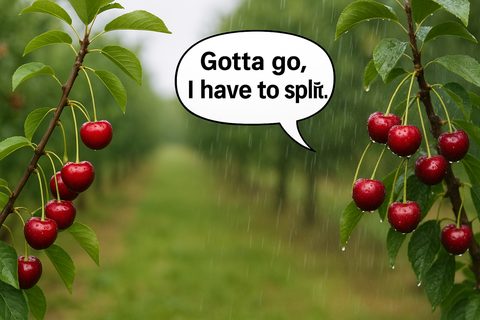
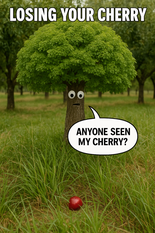

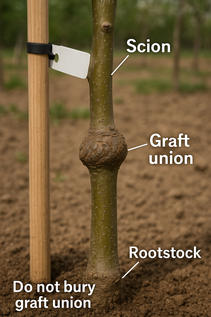
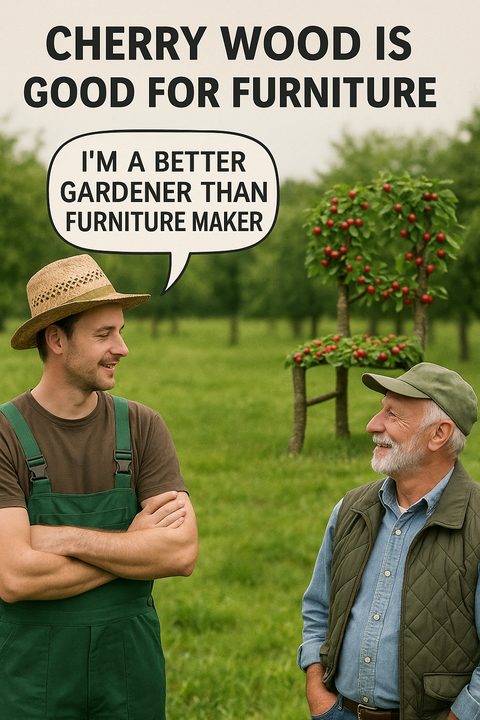
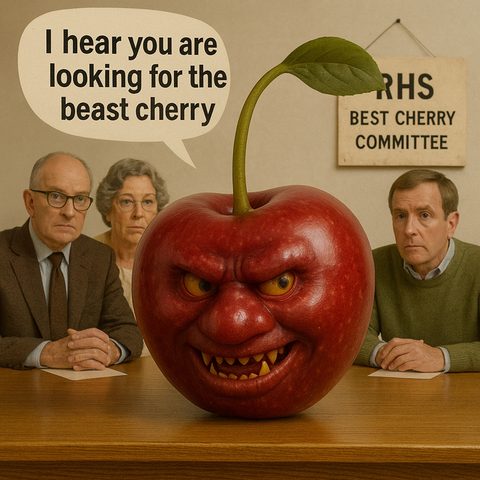

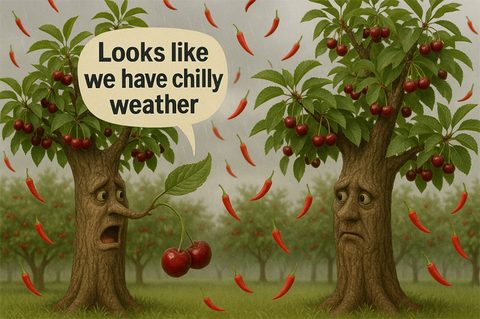


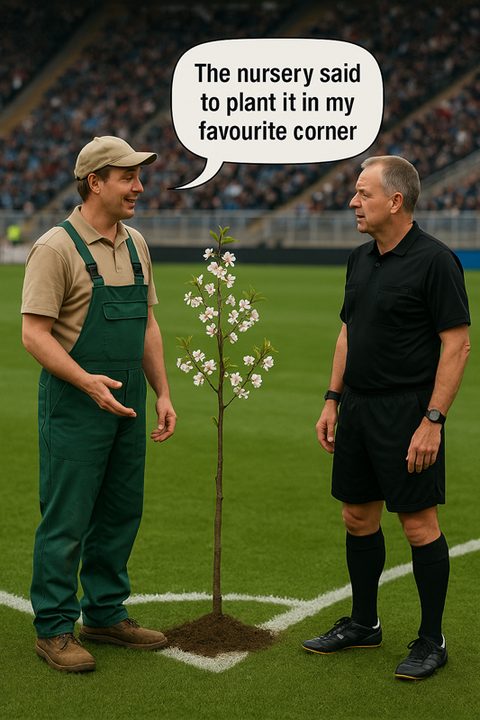

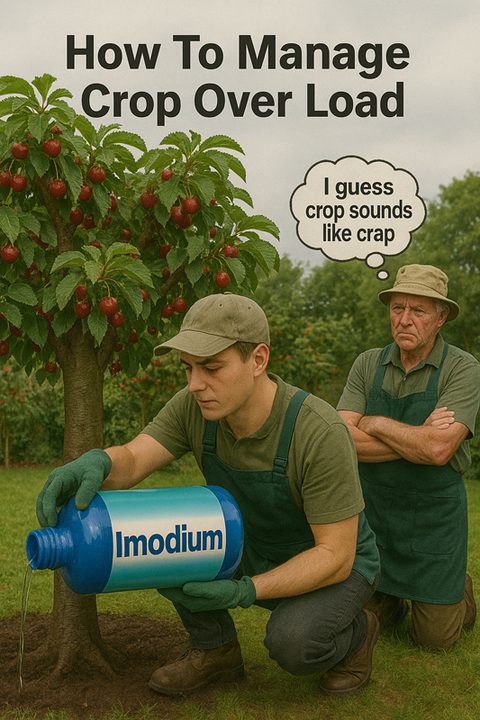
-TN.png)
